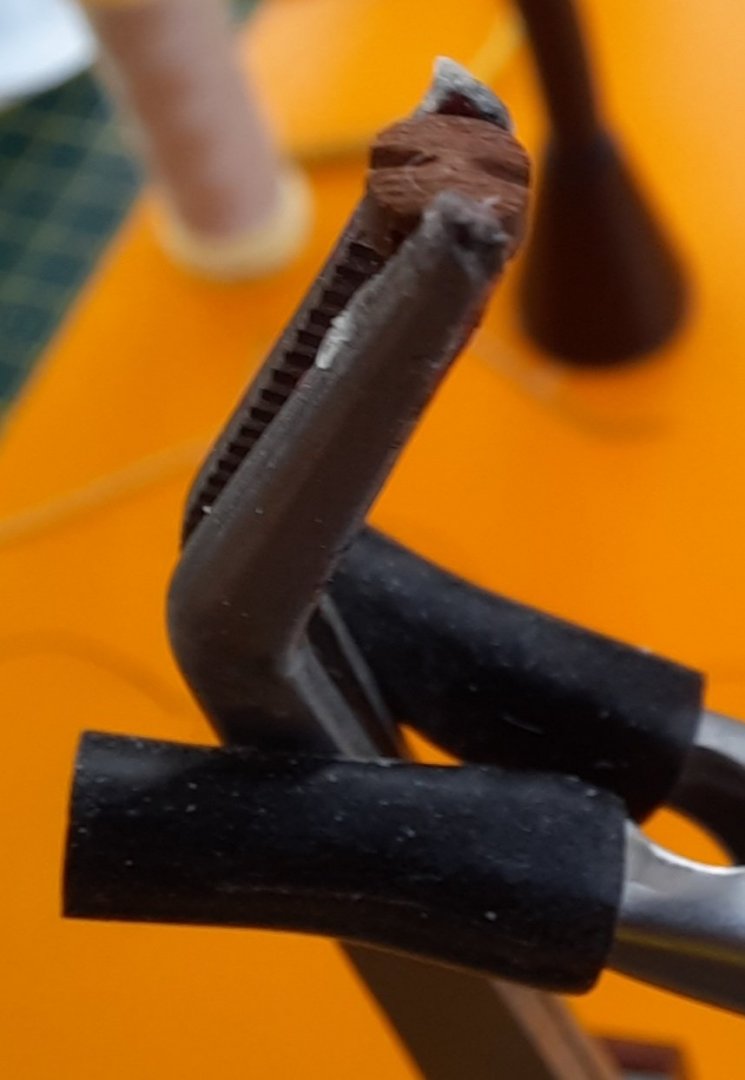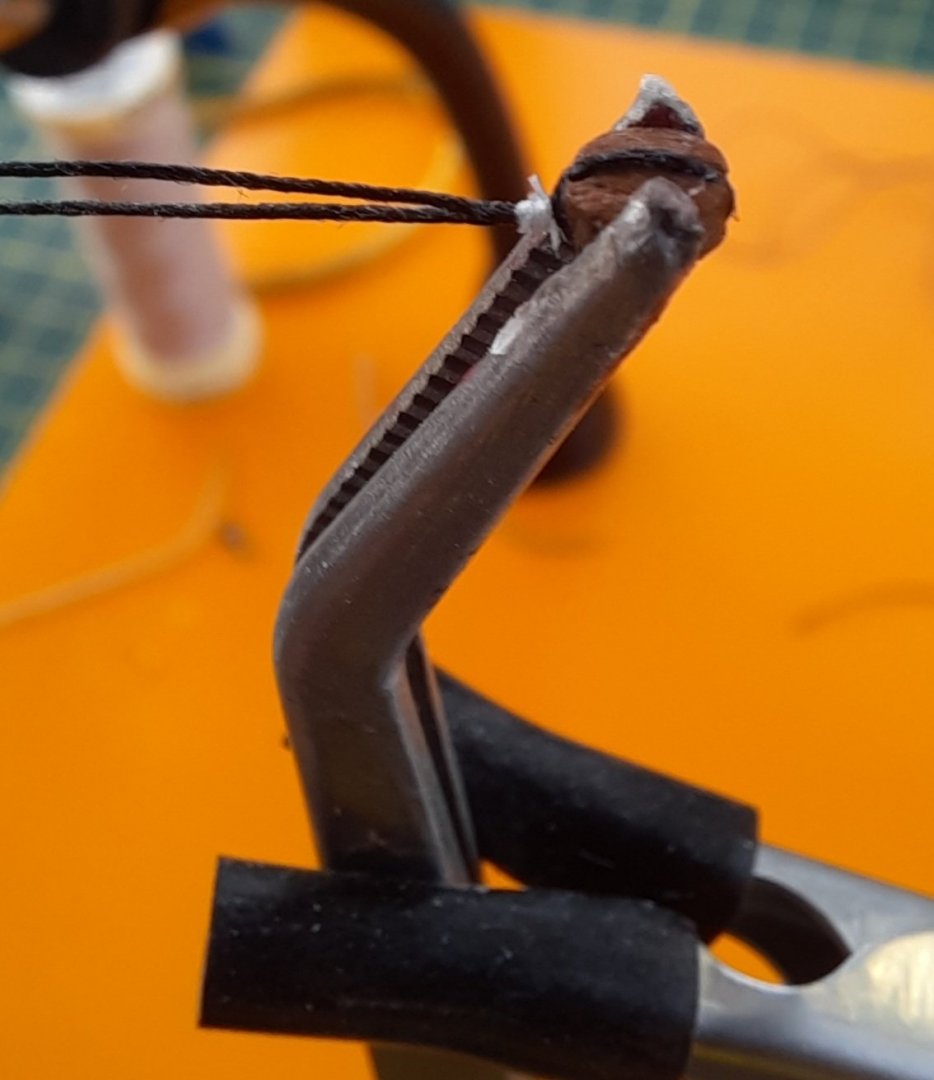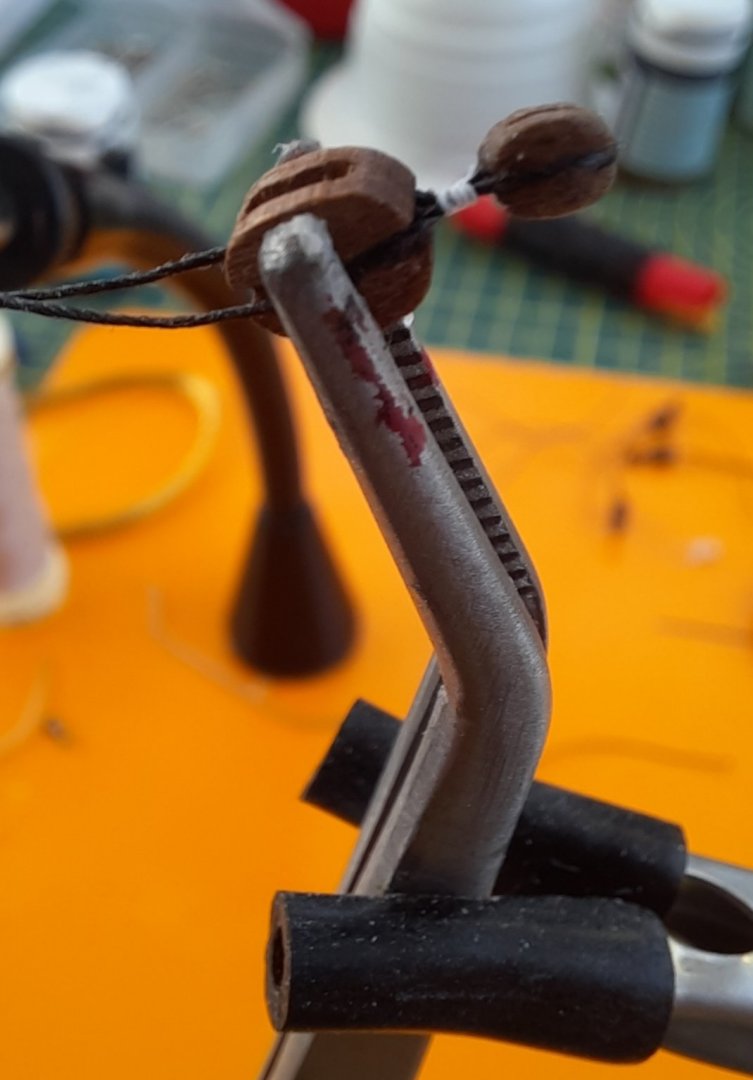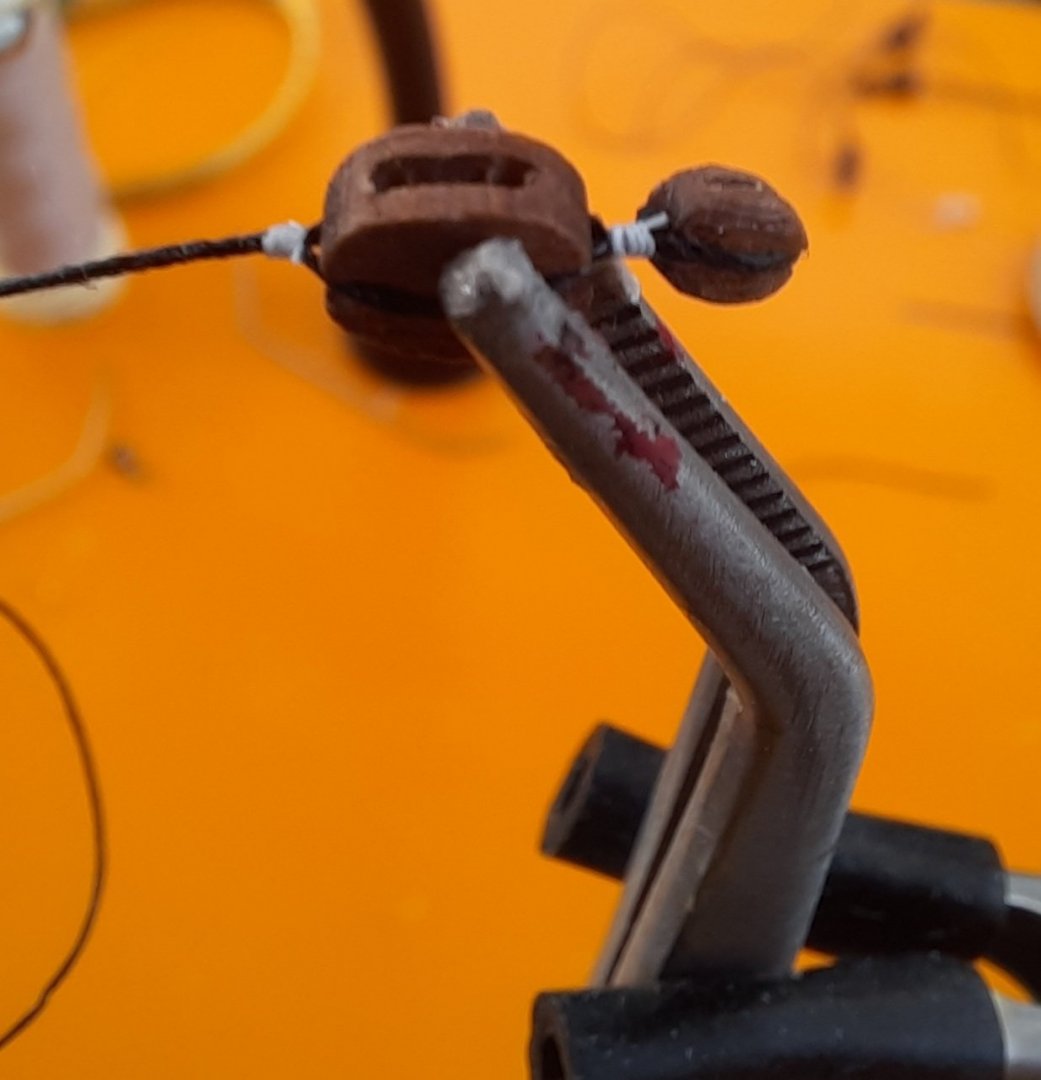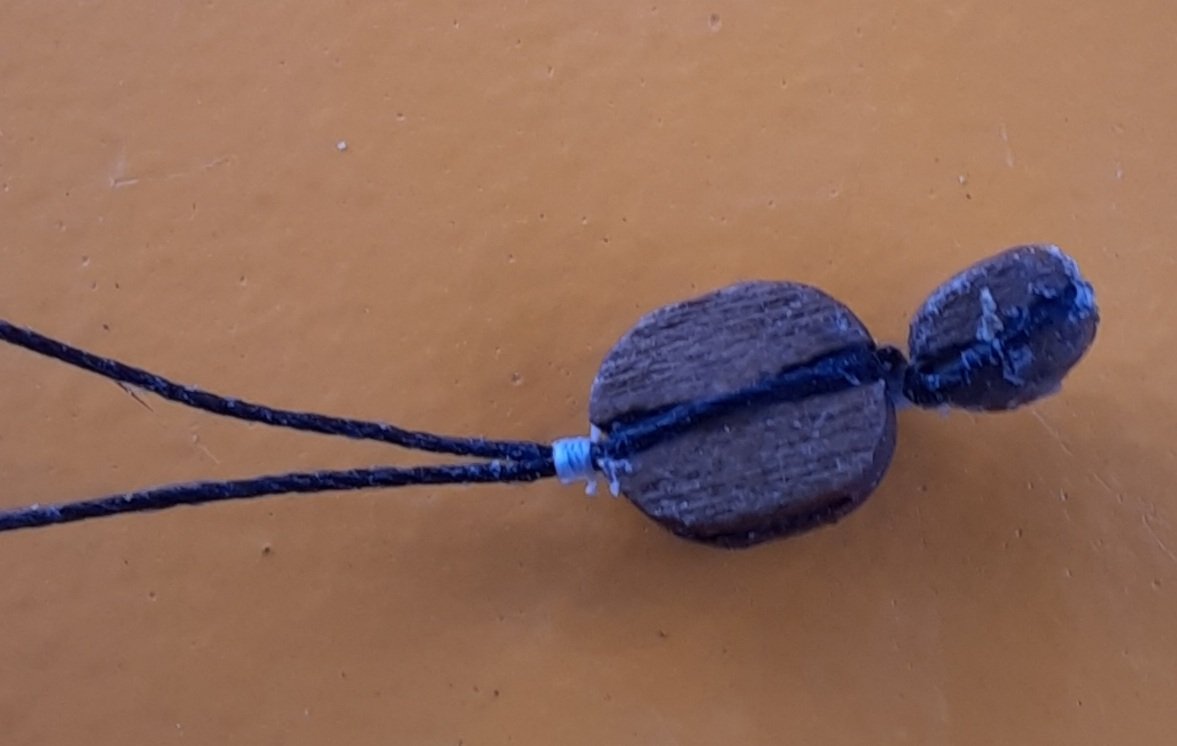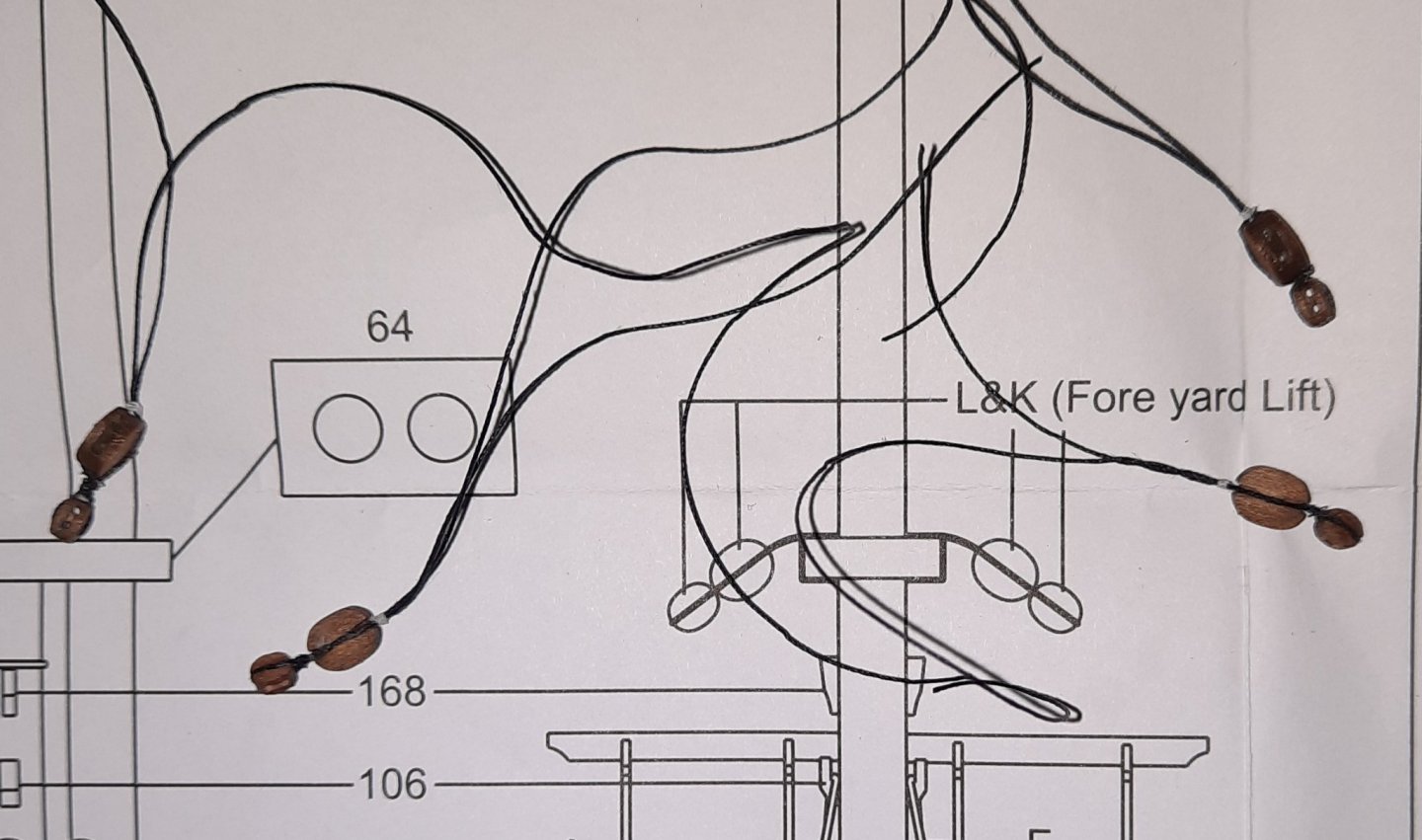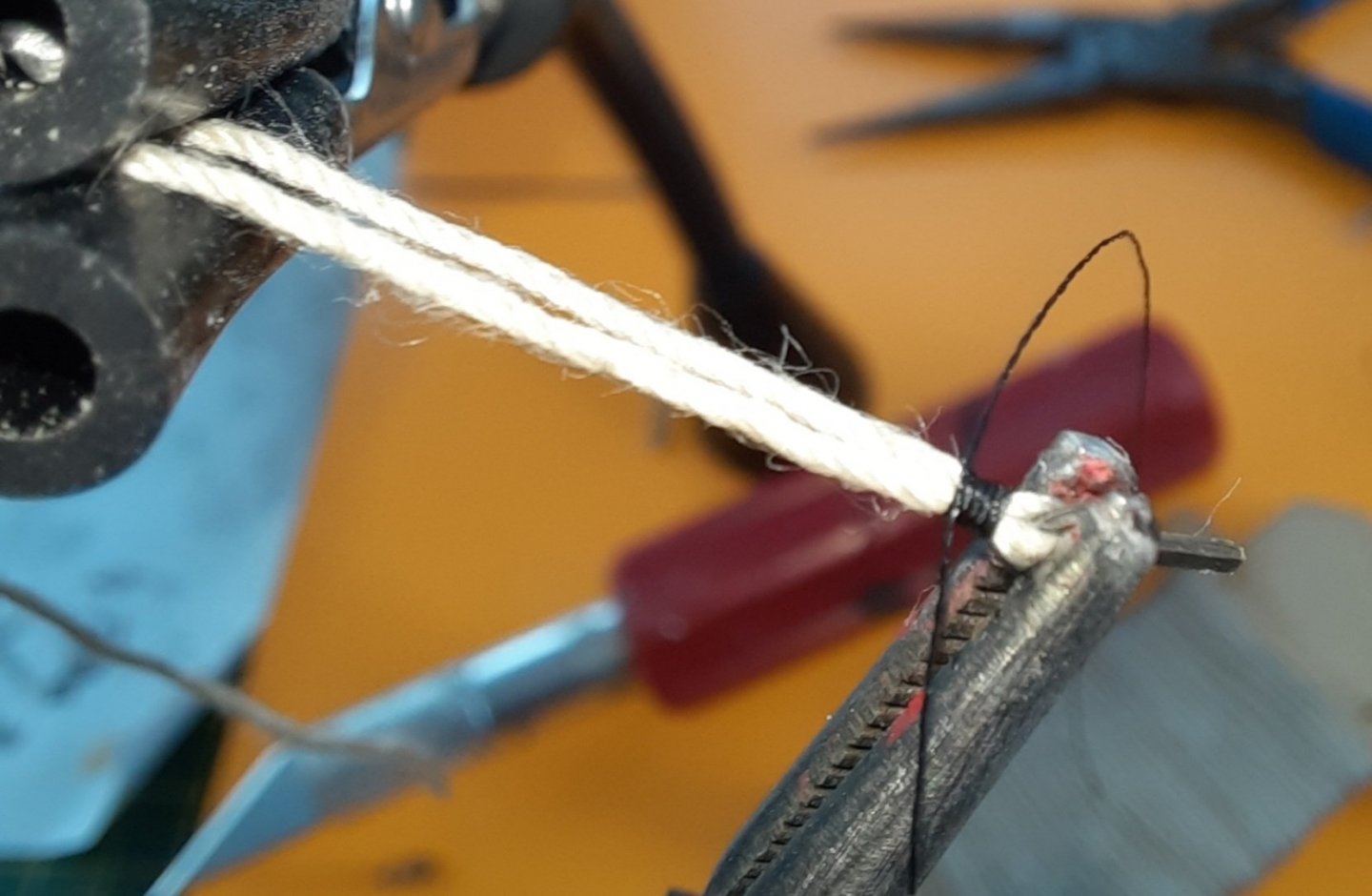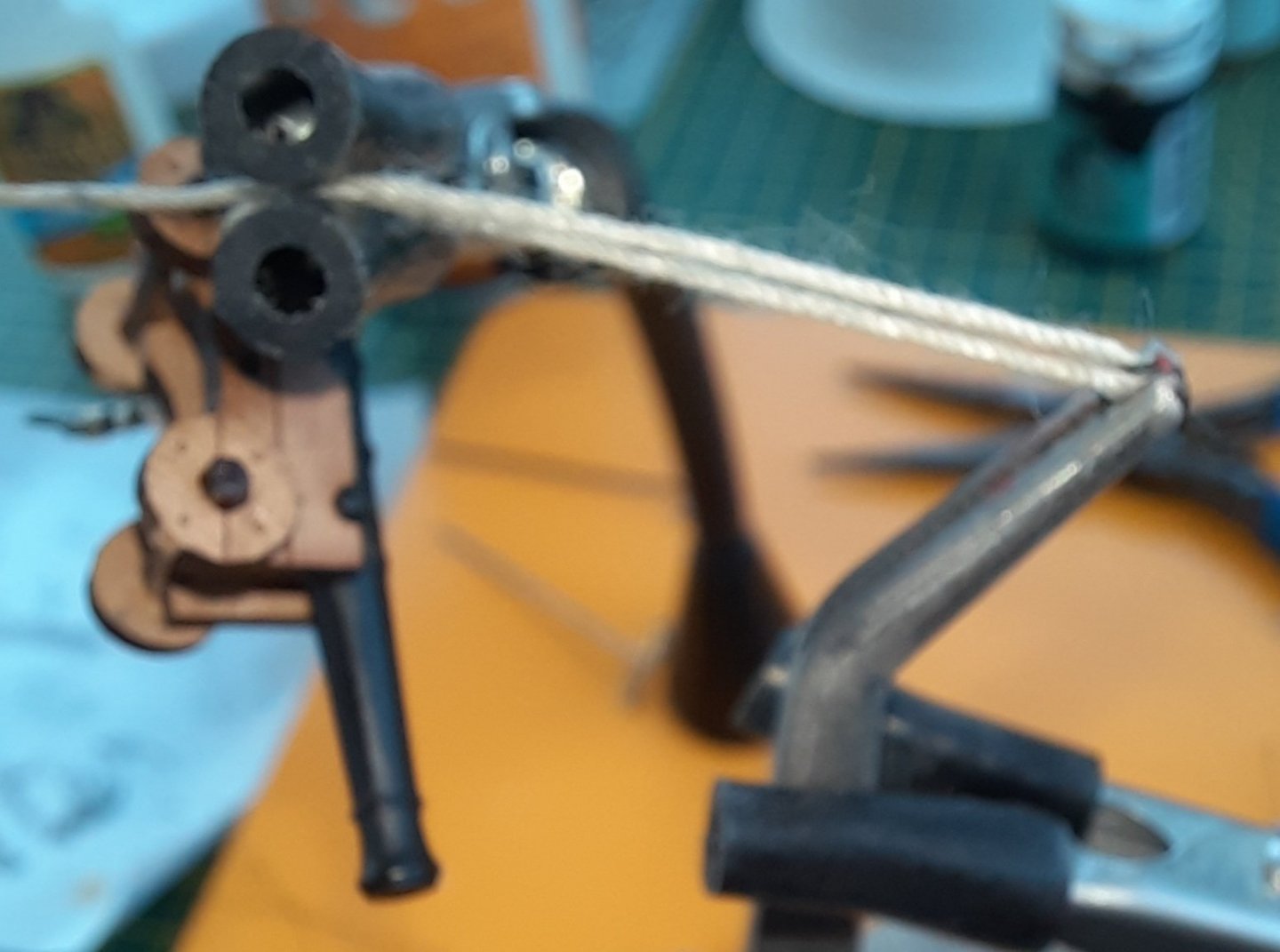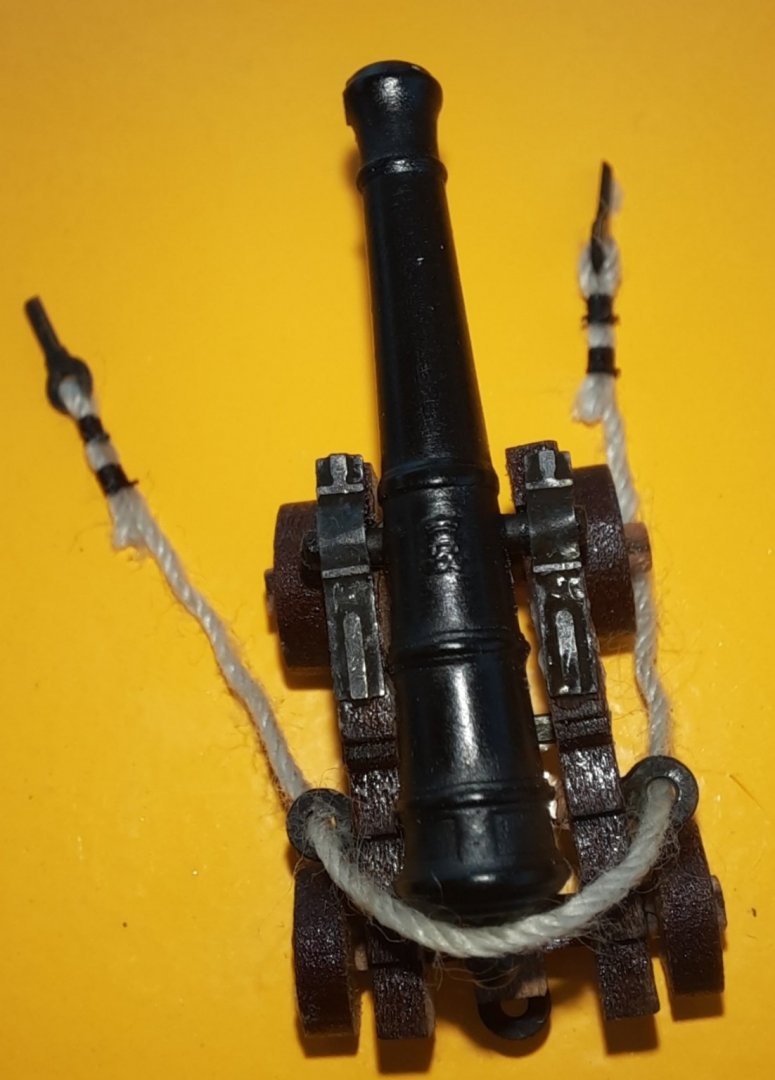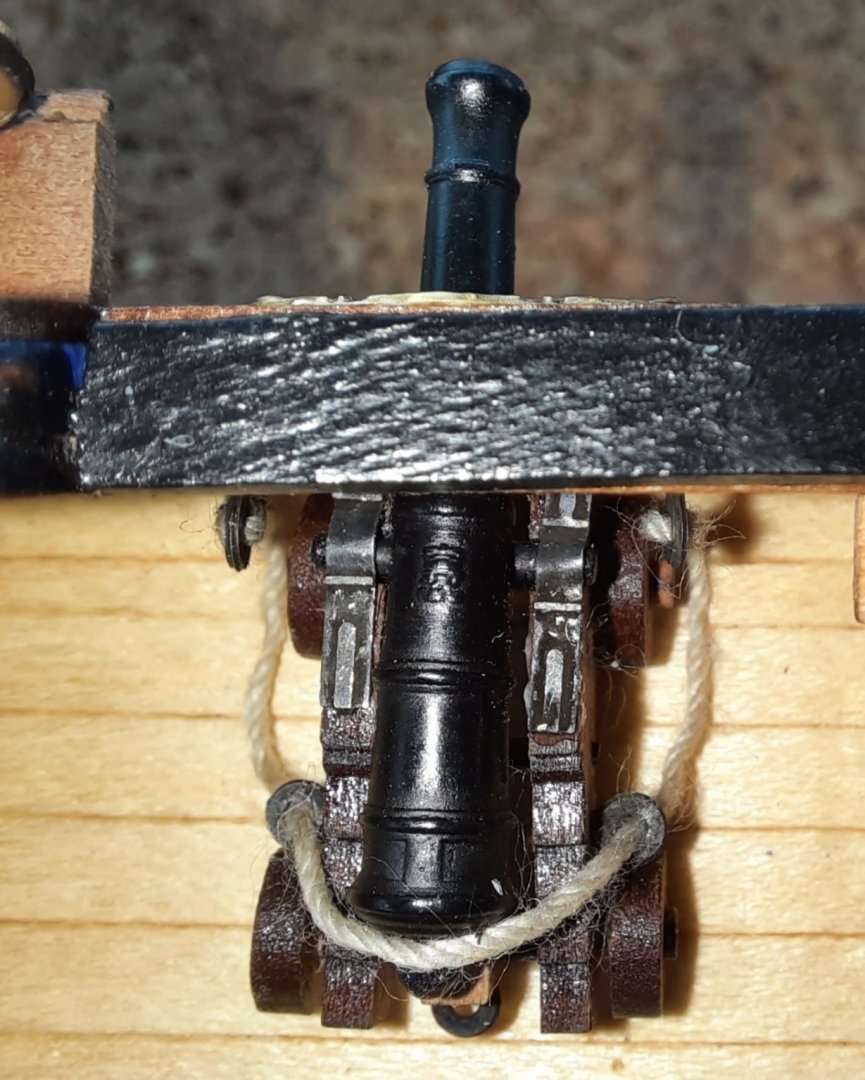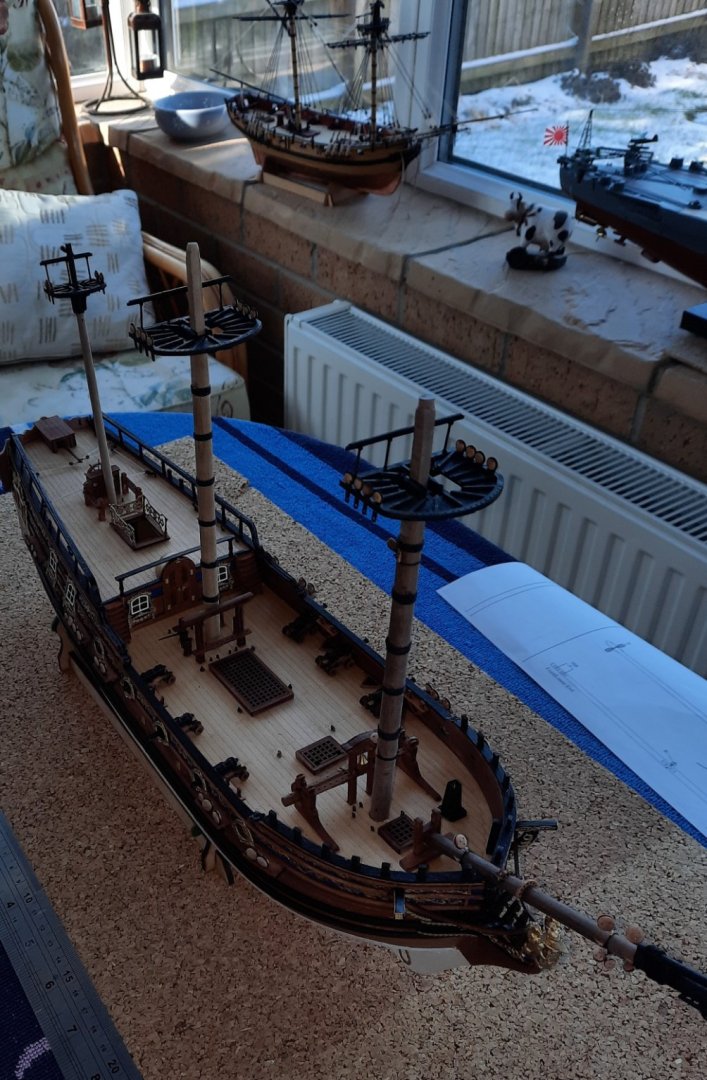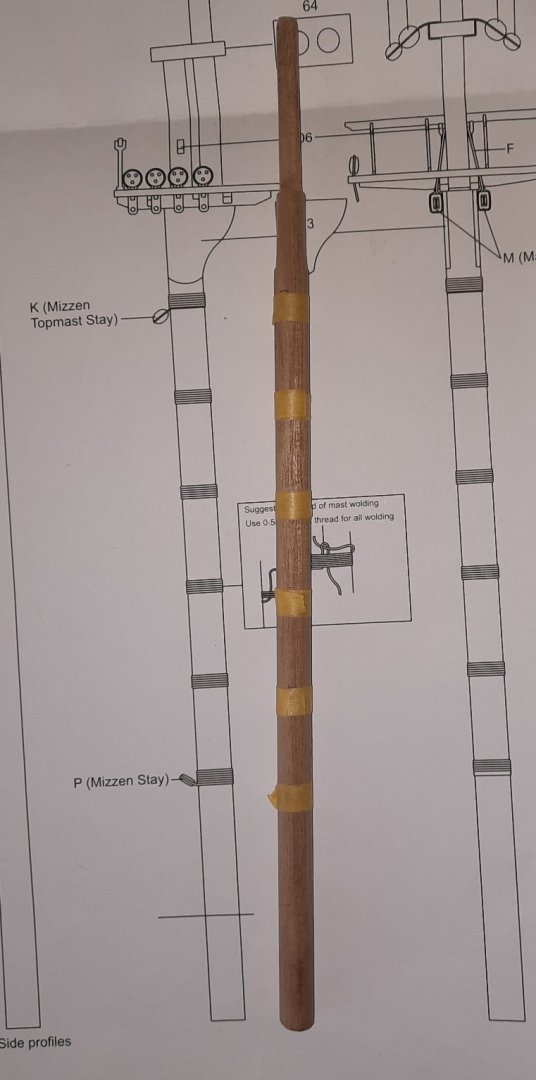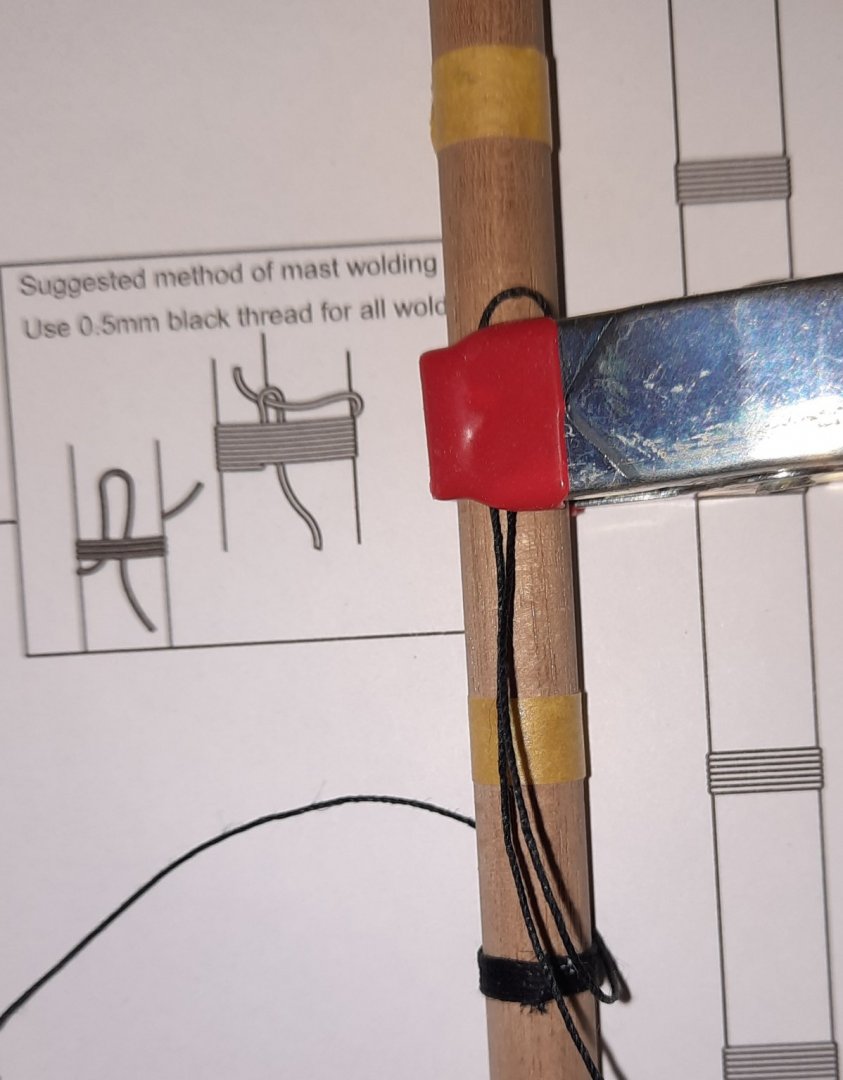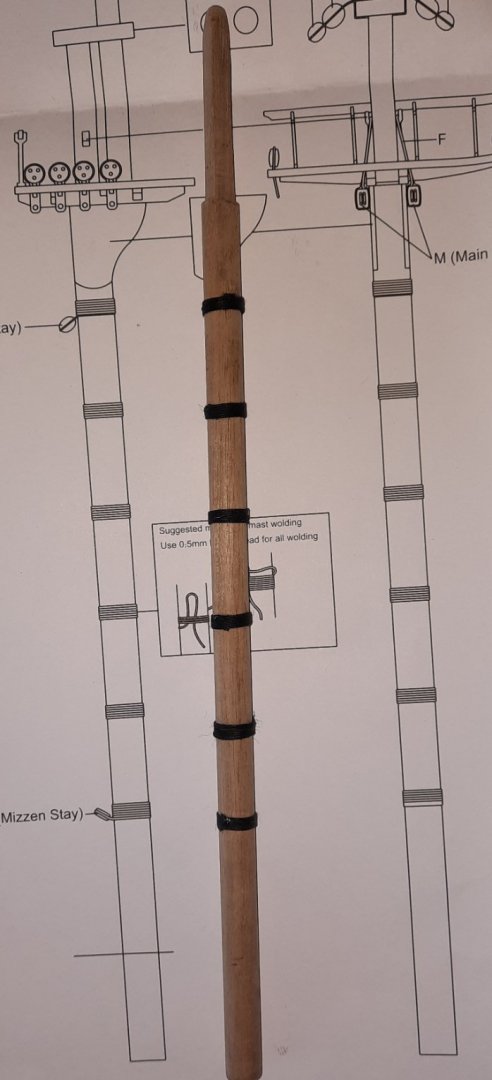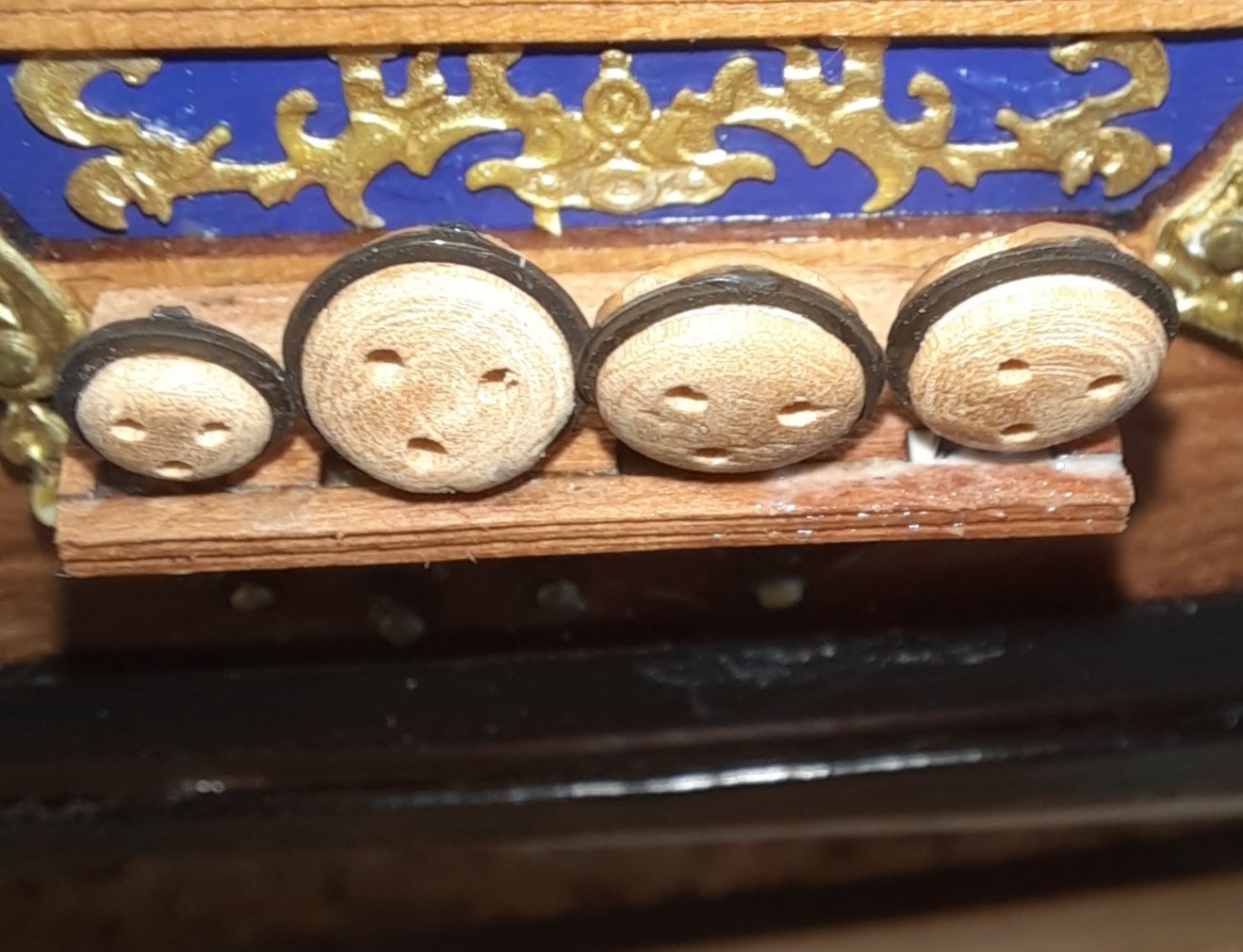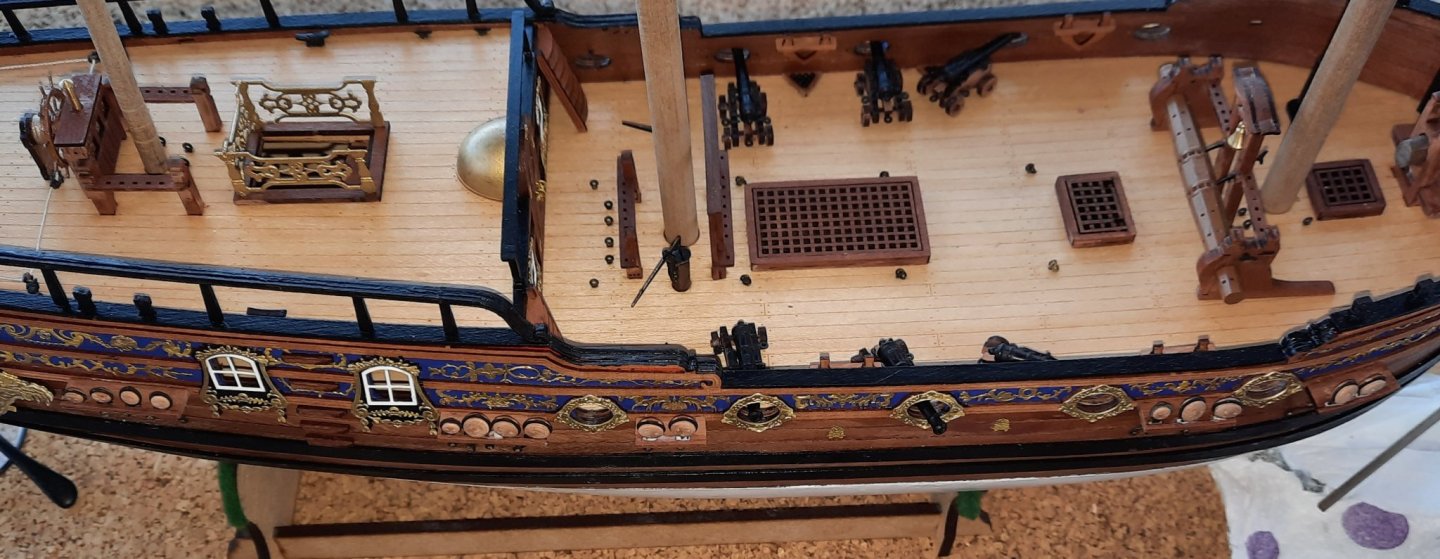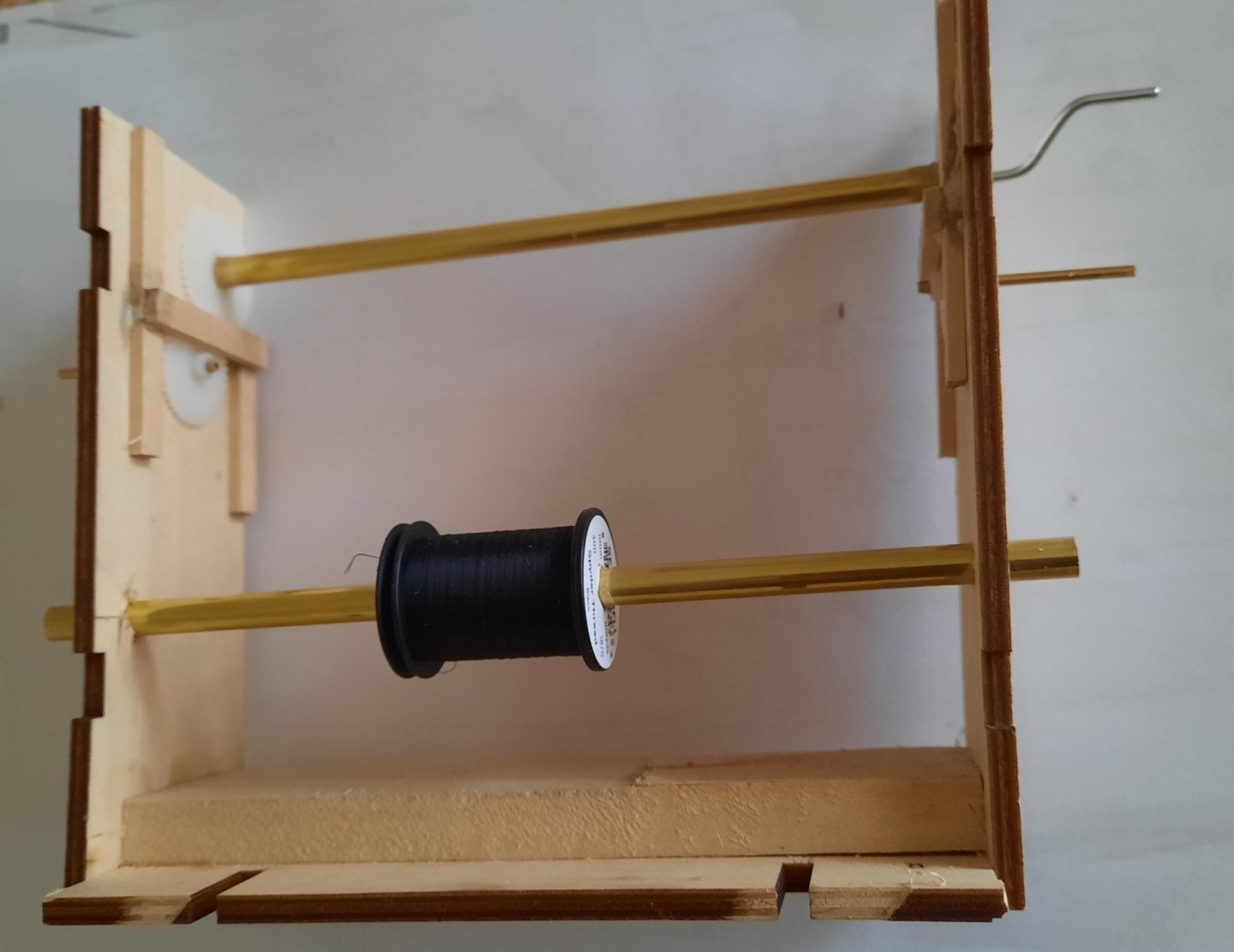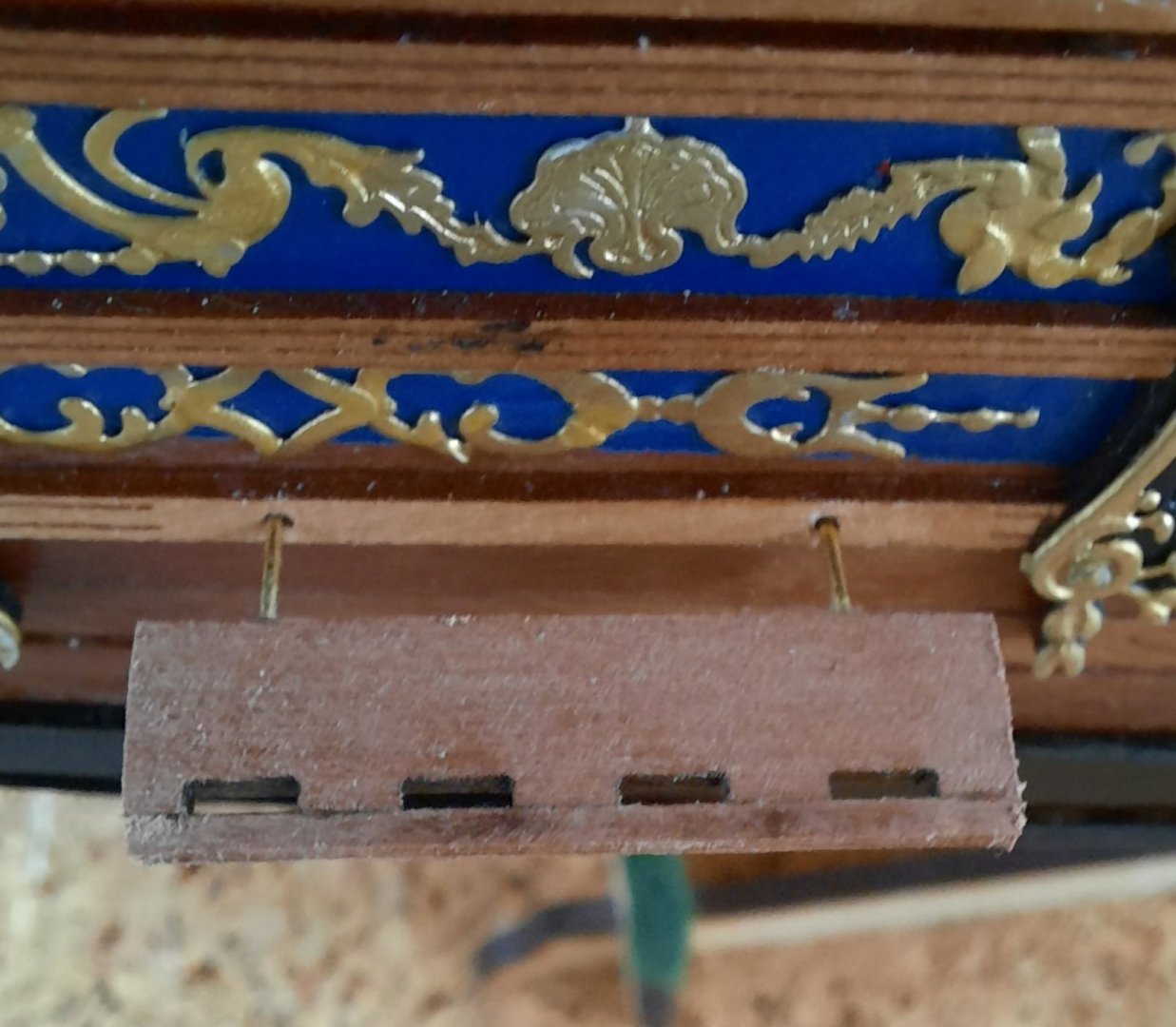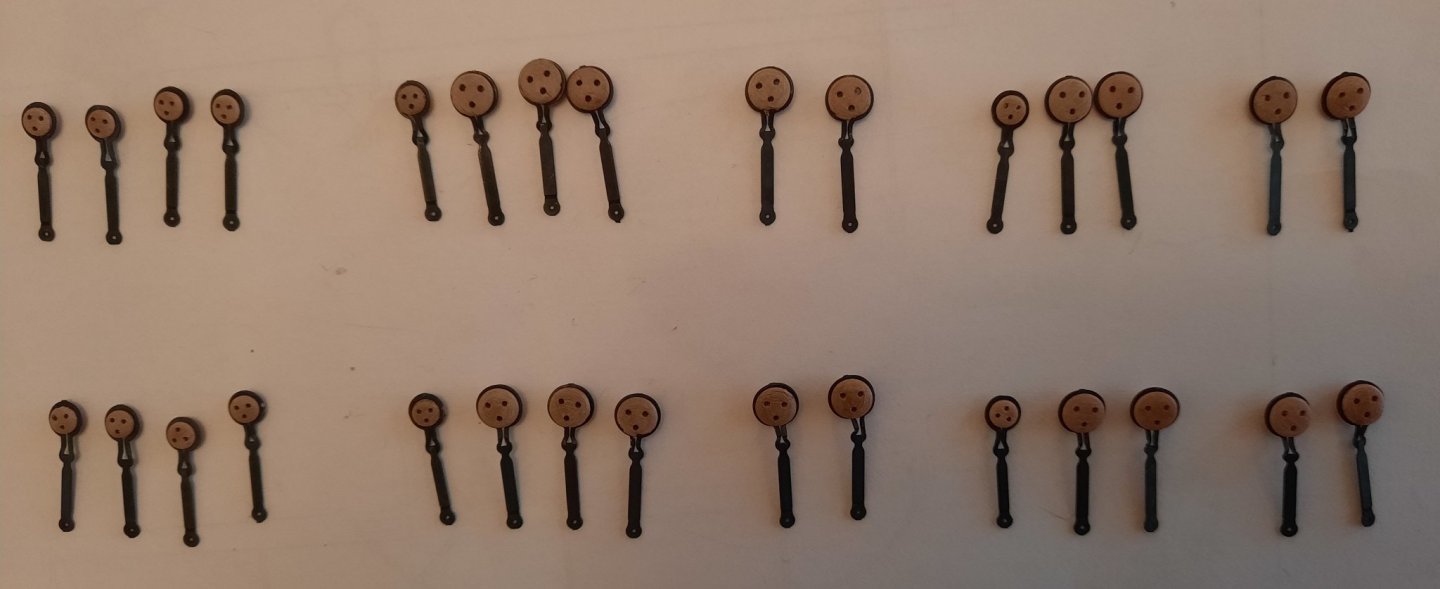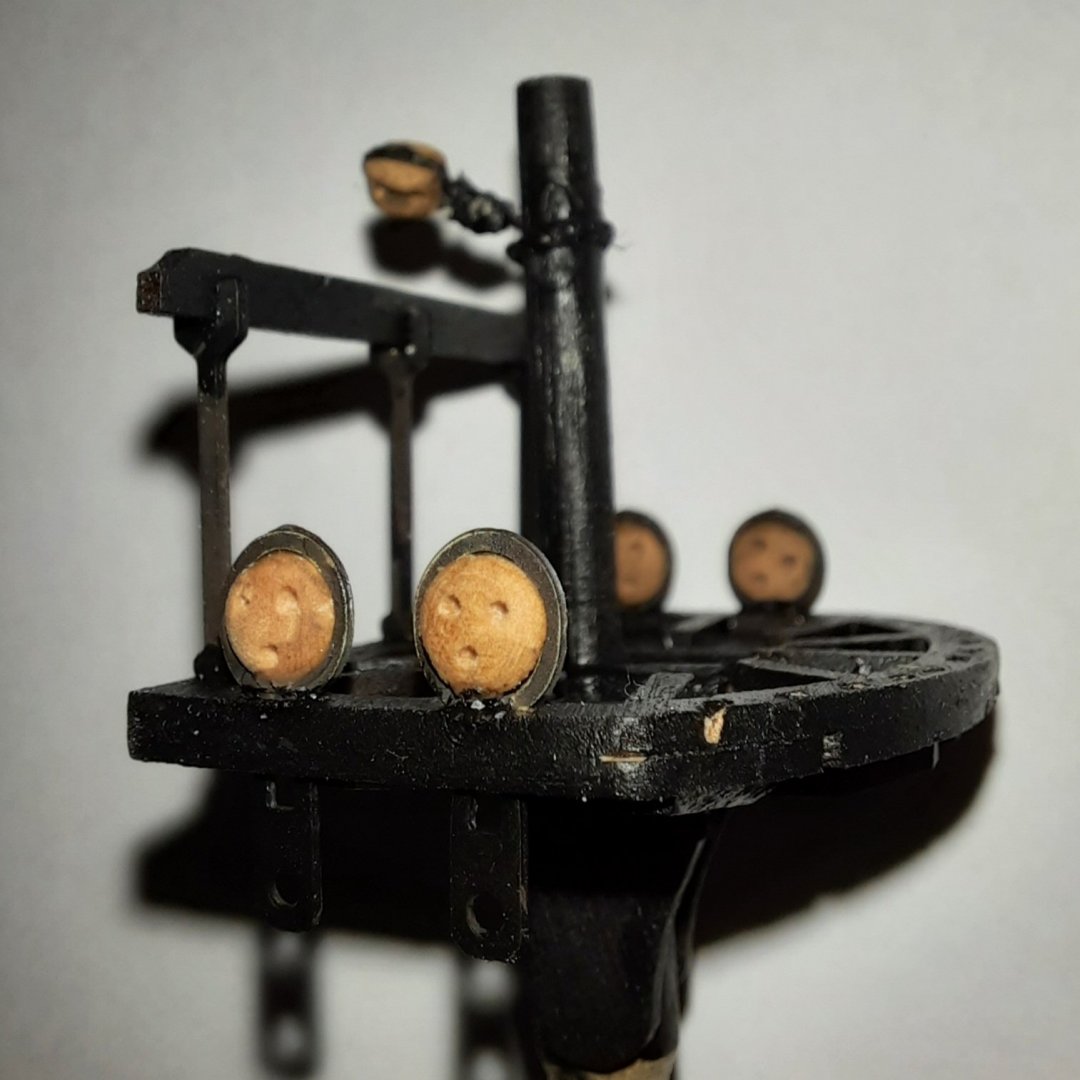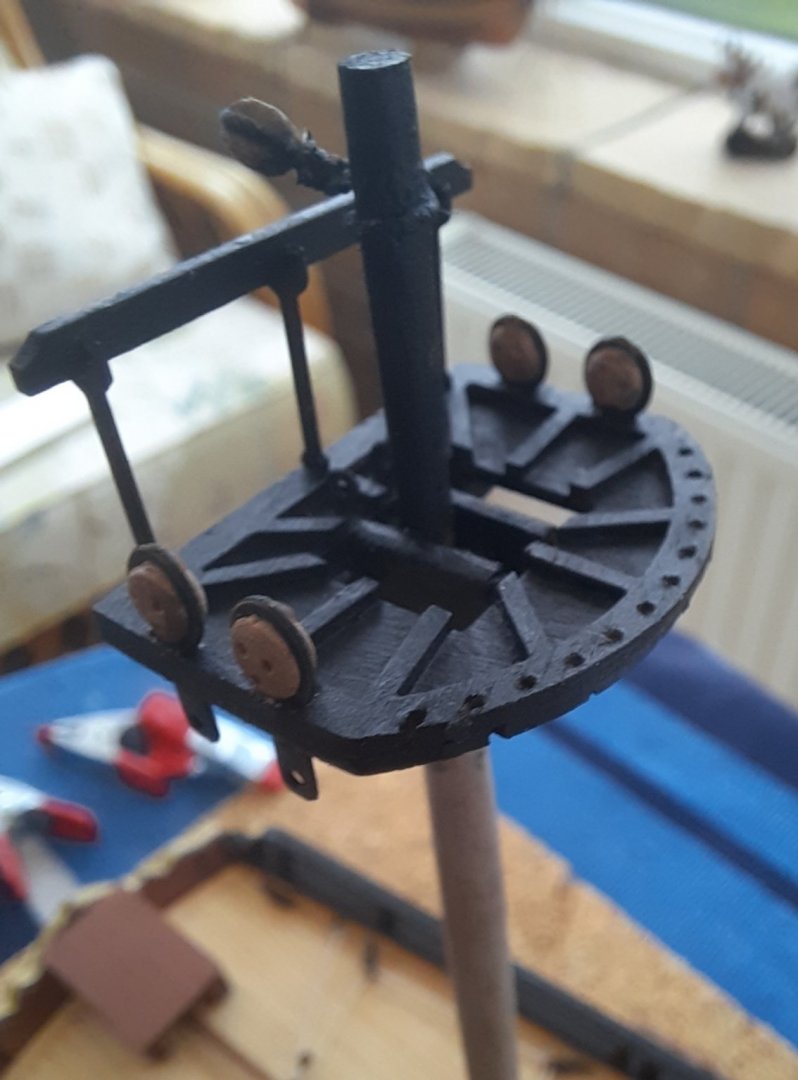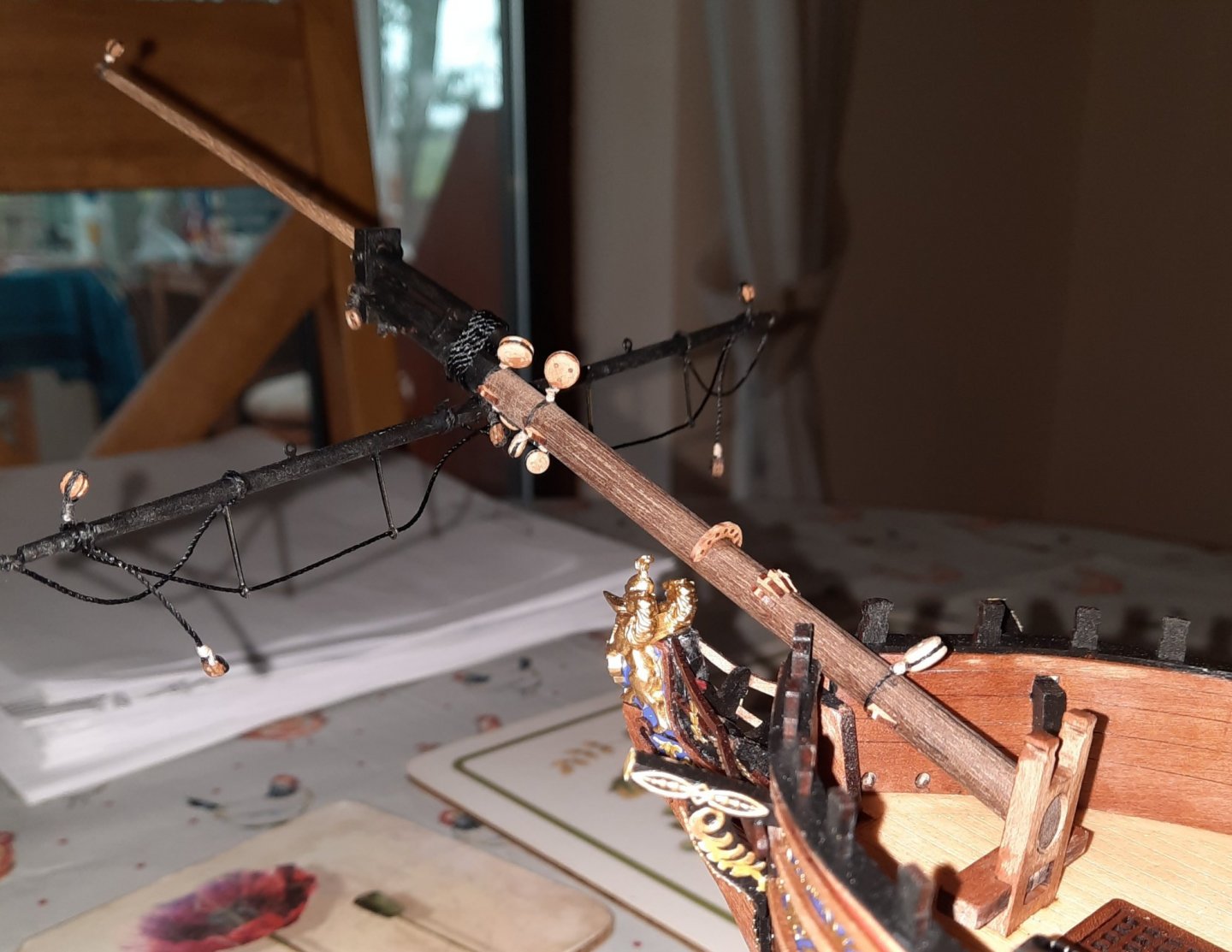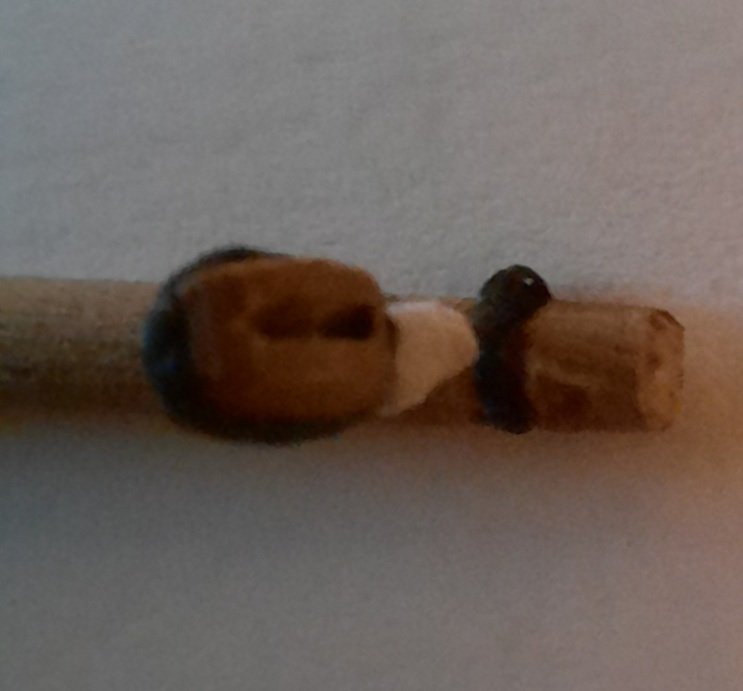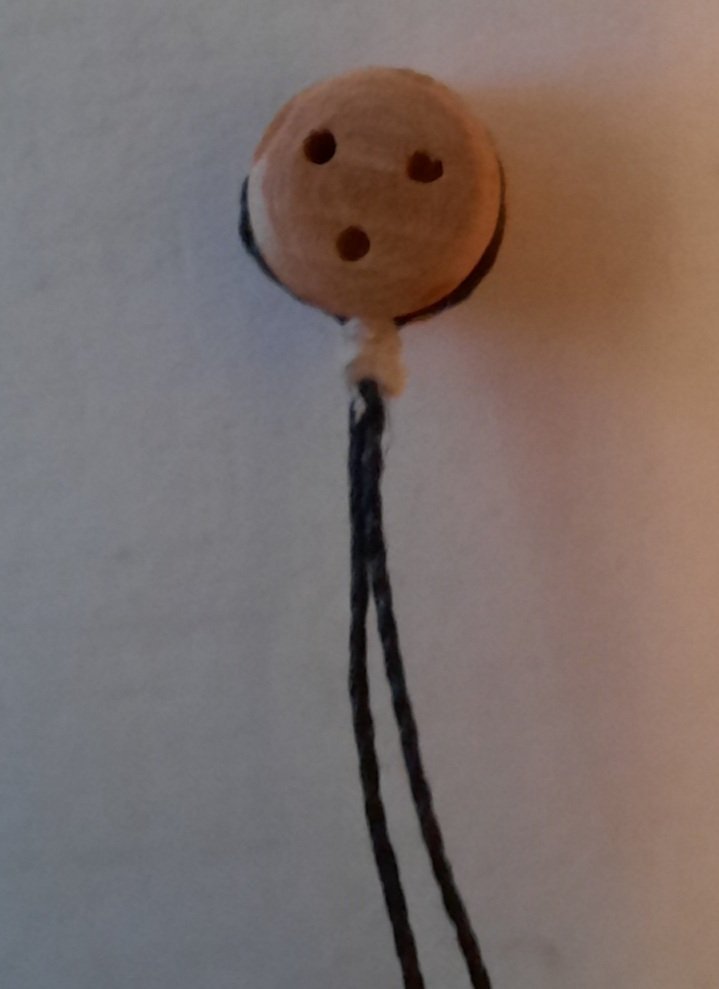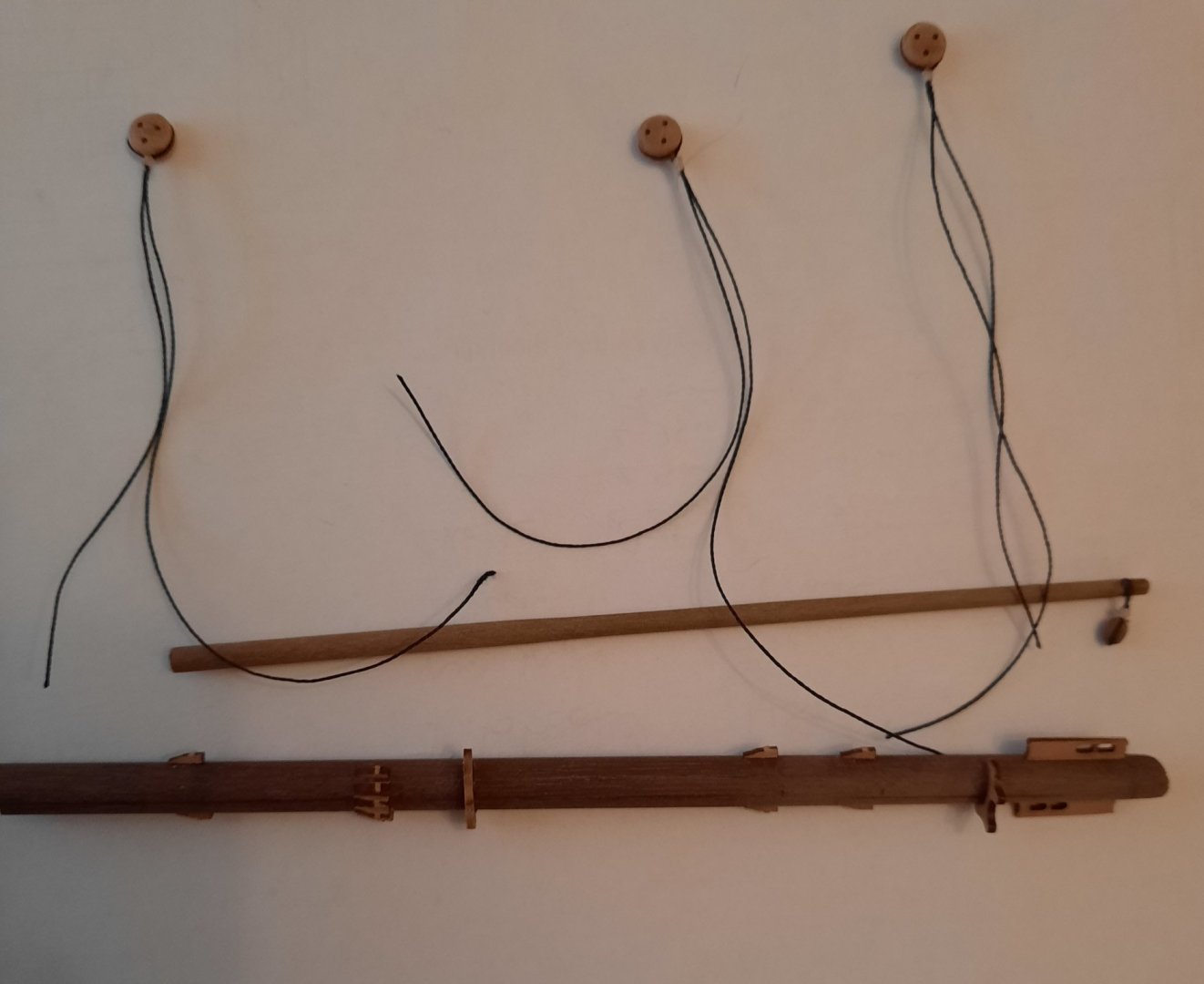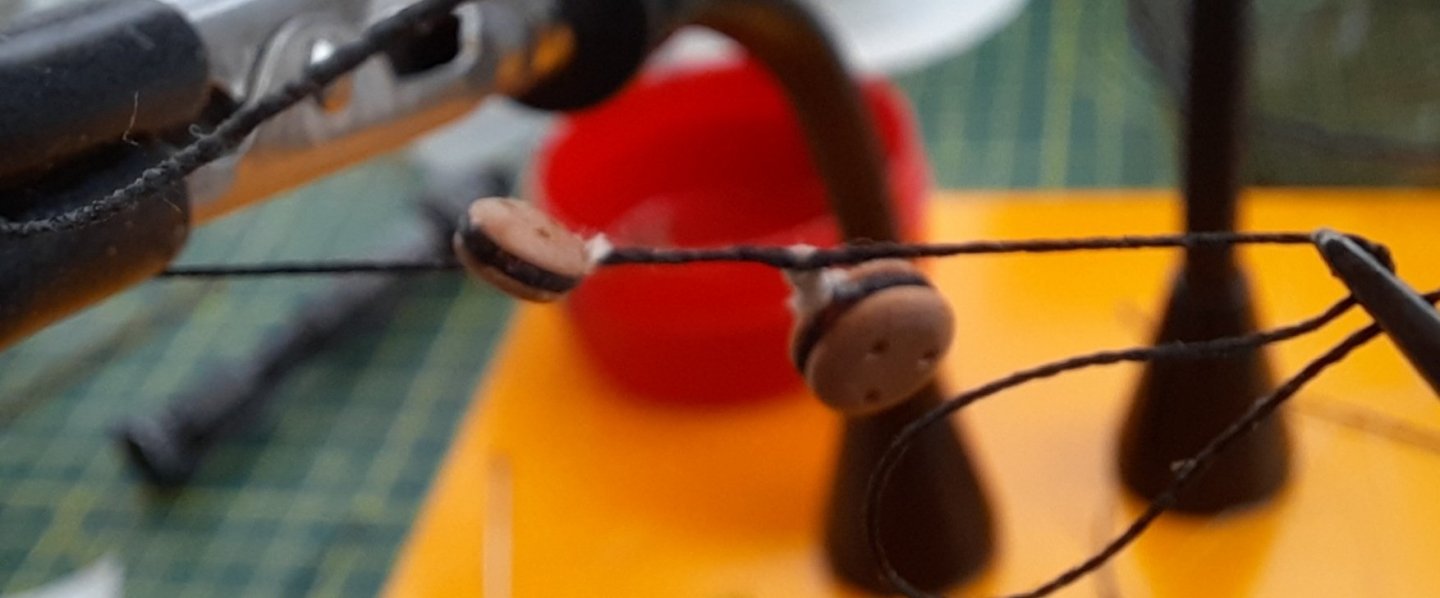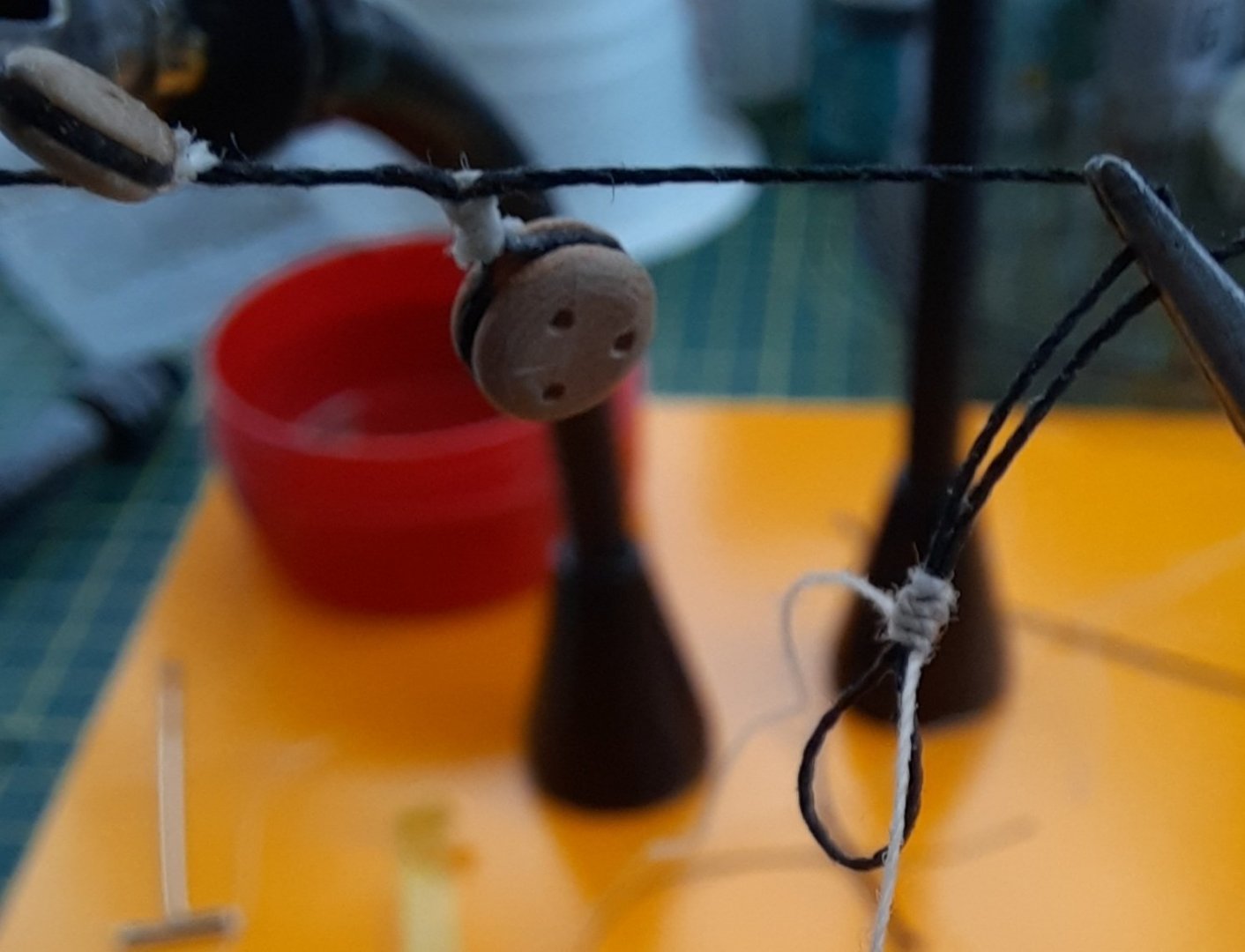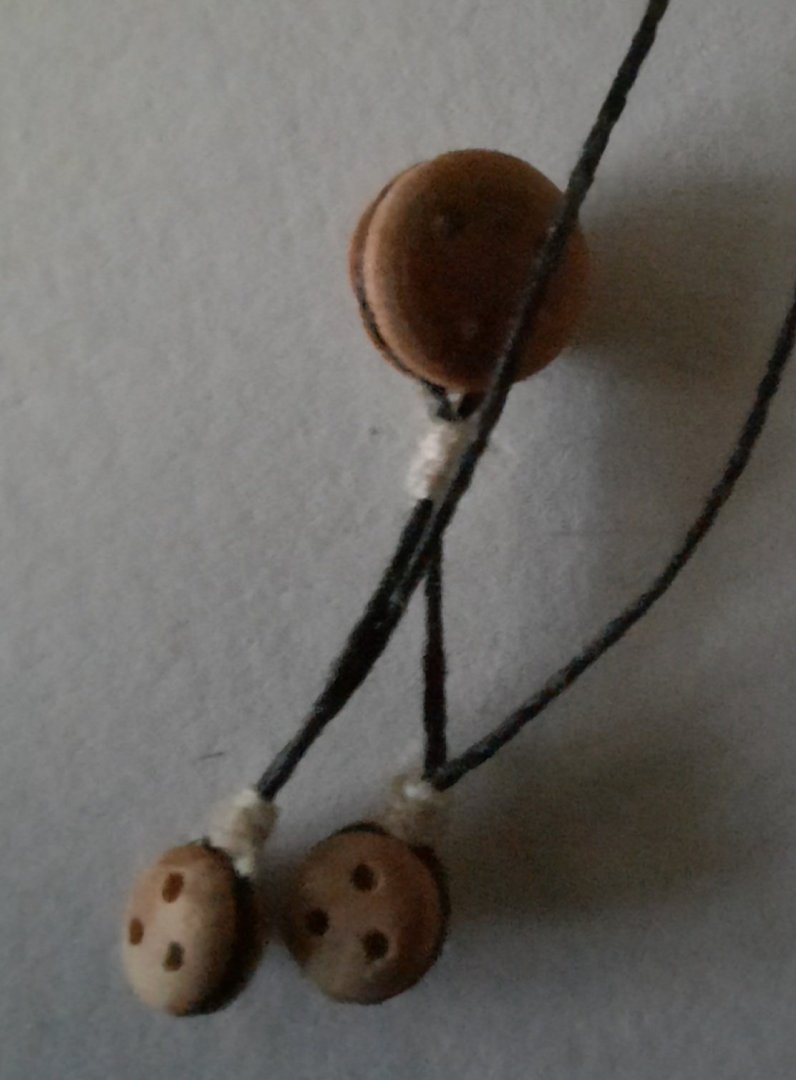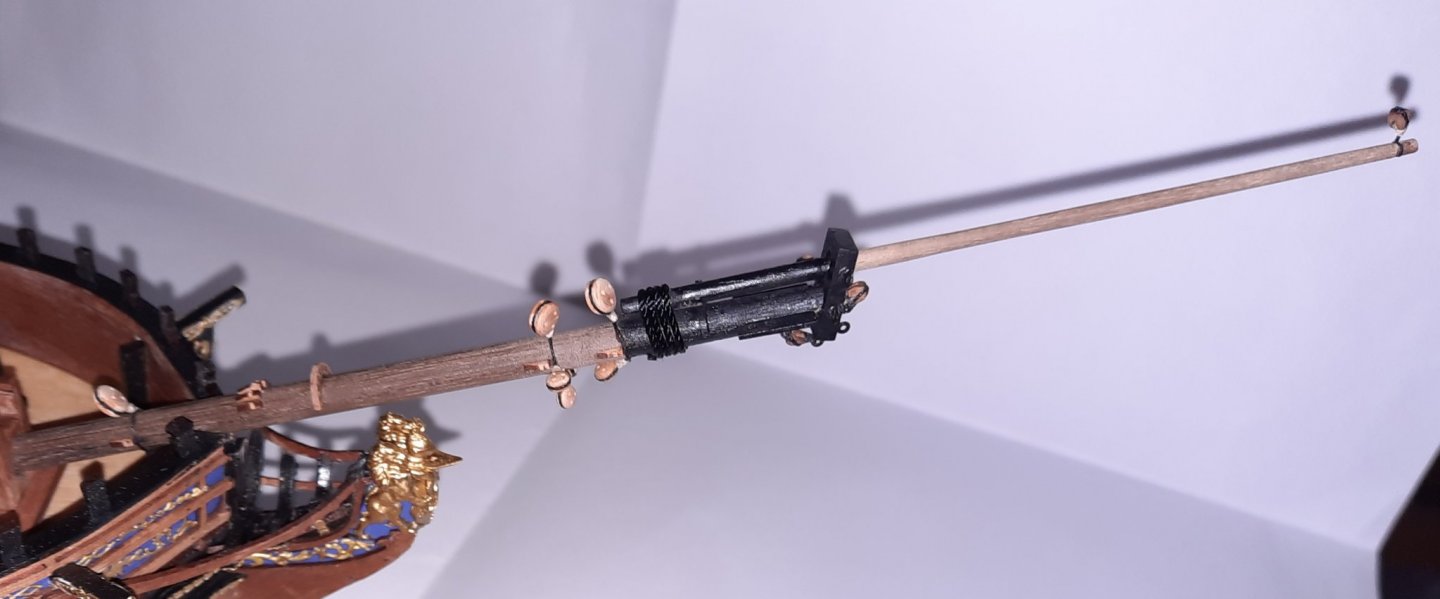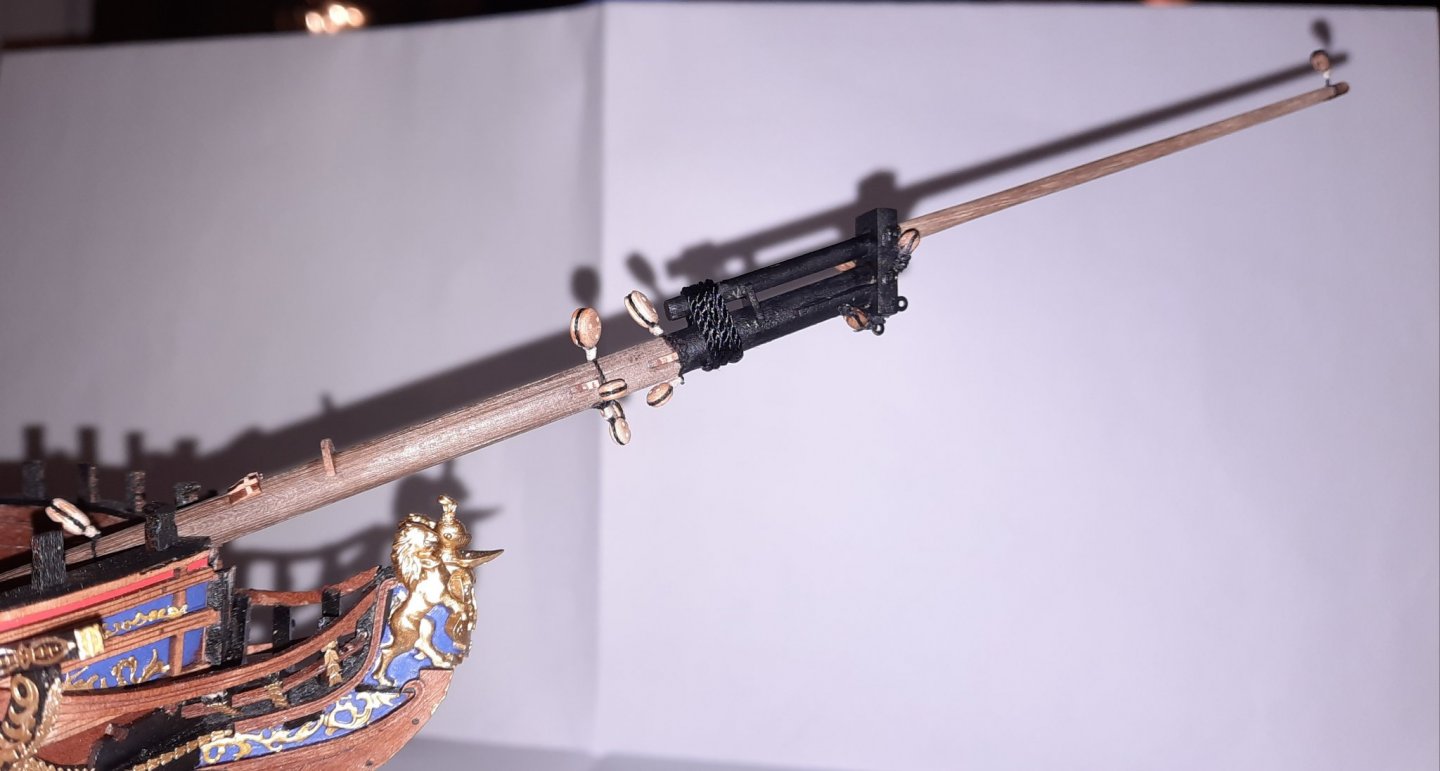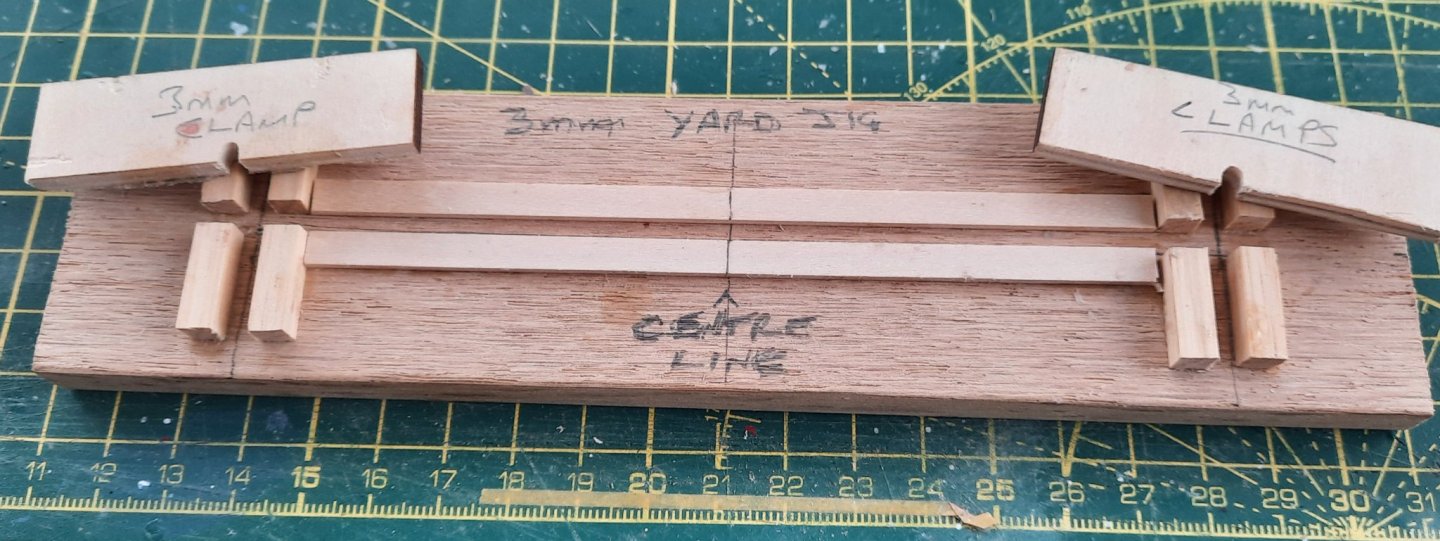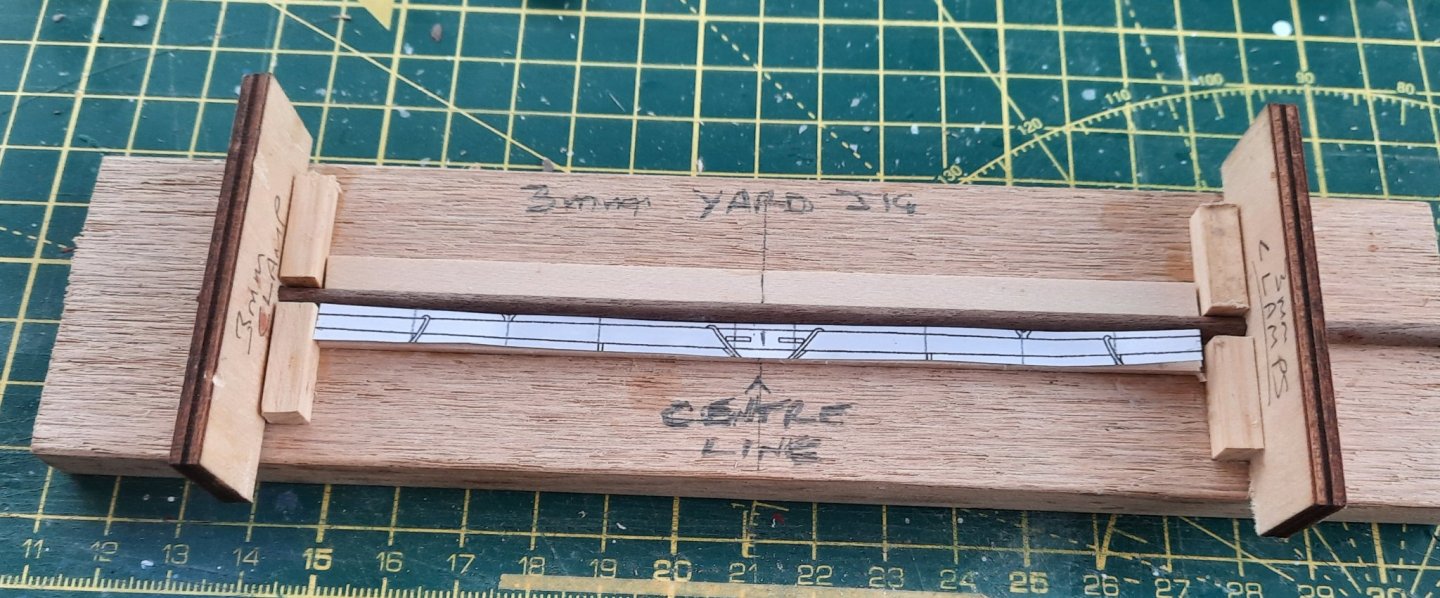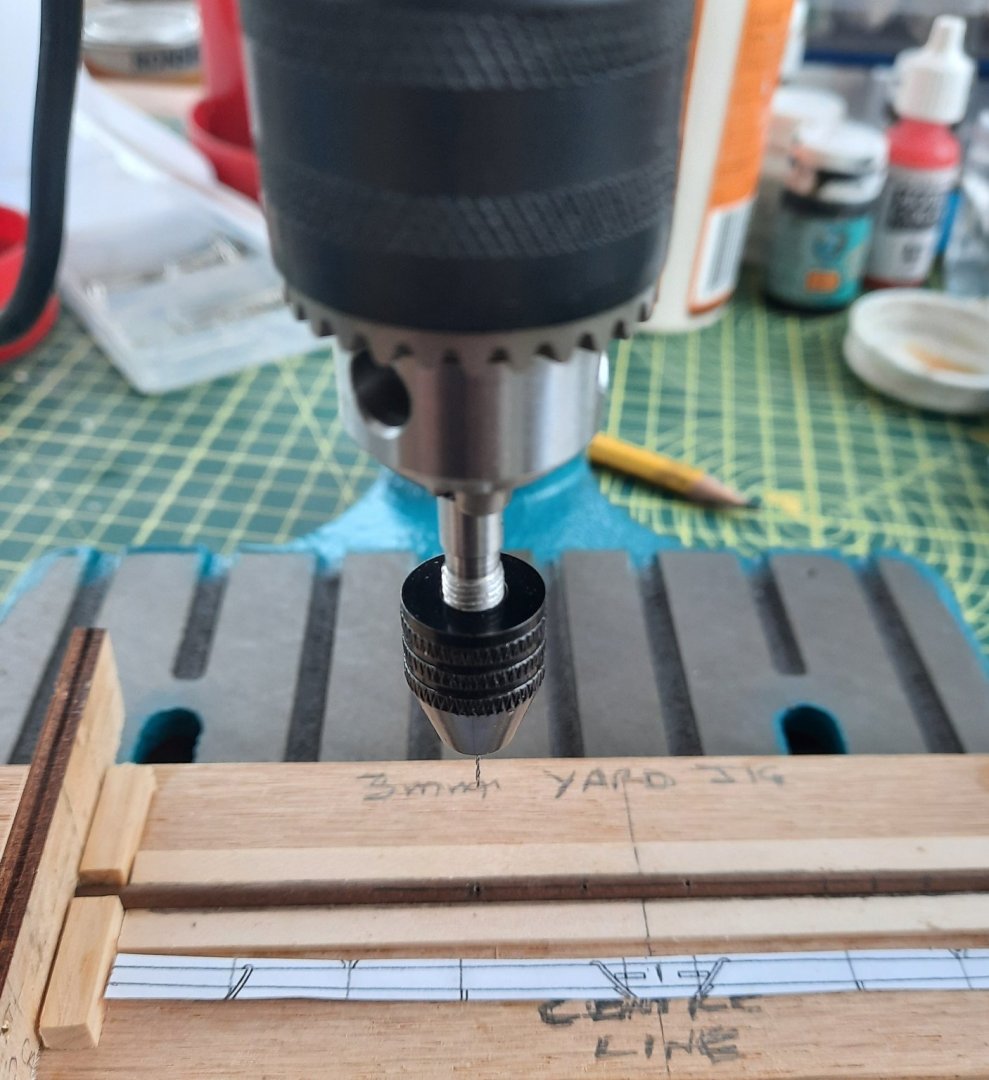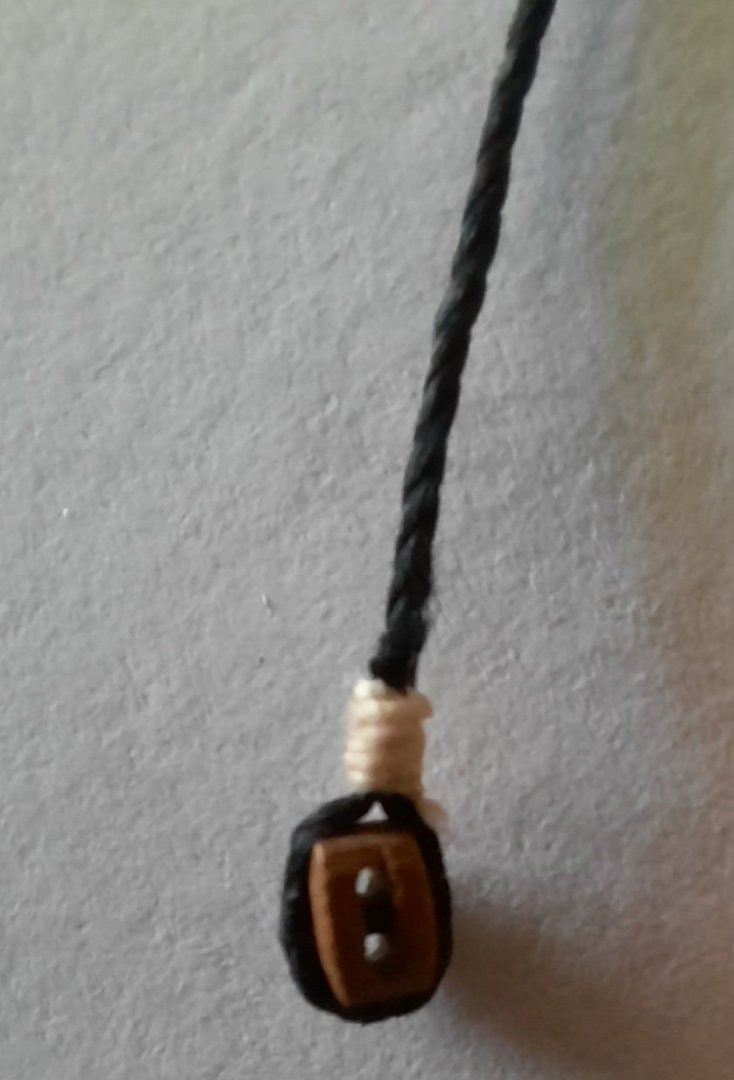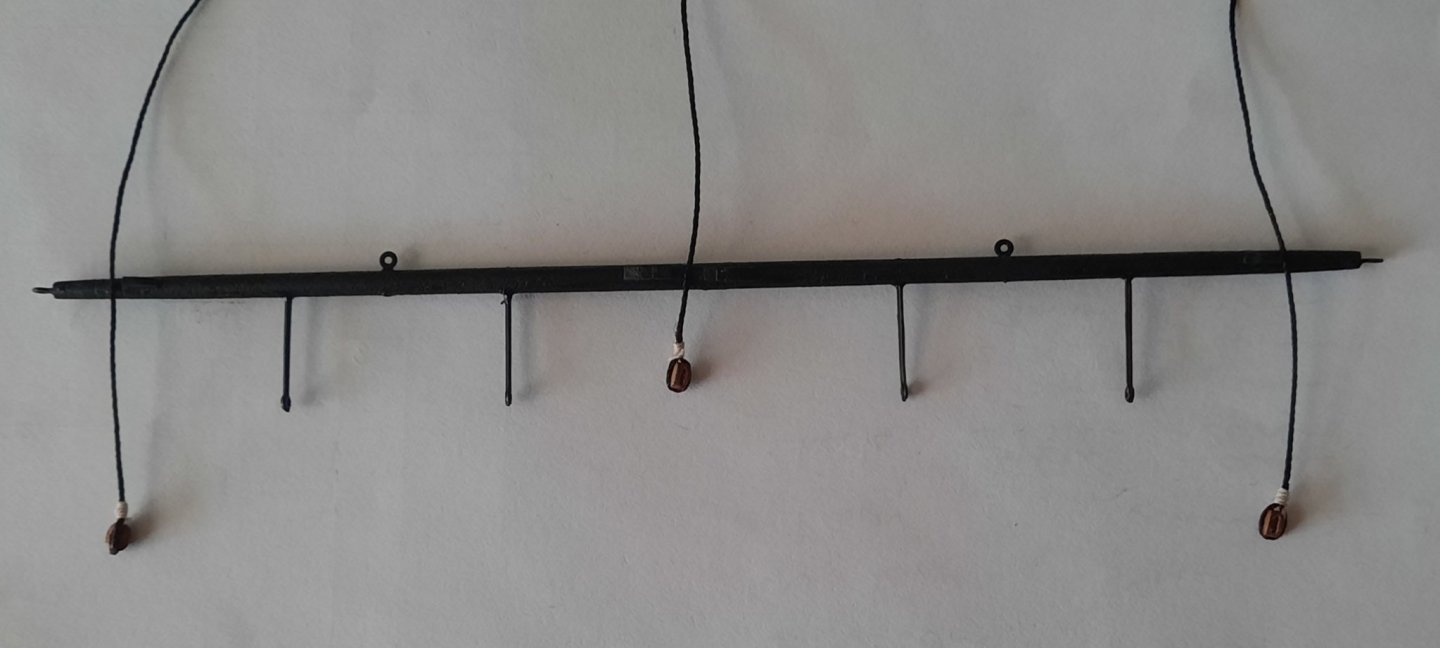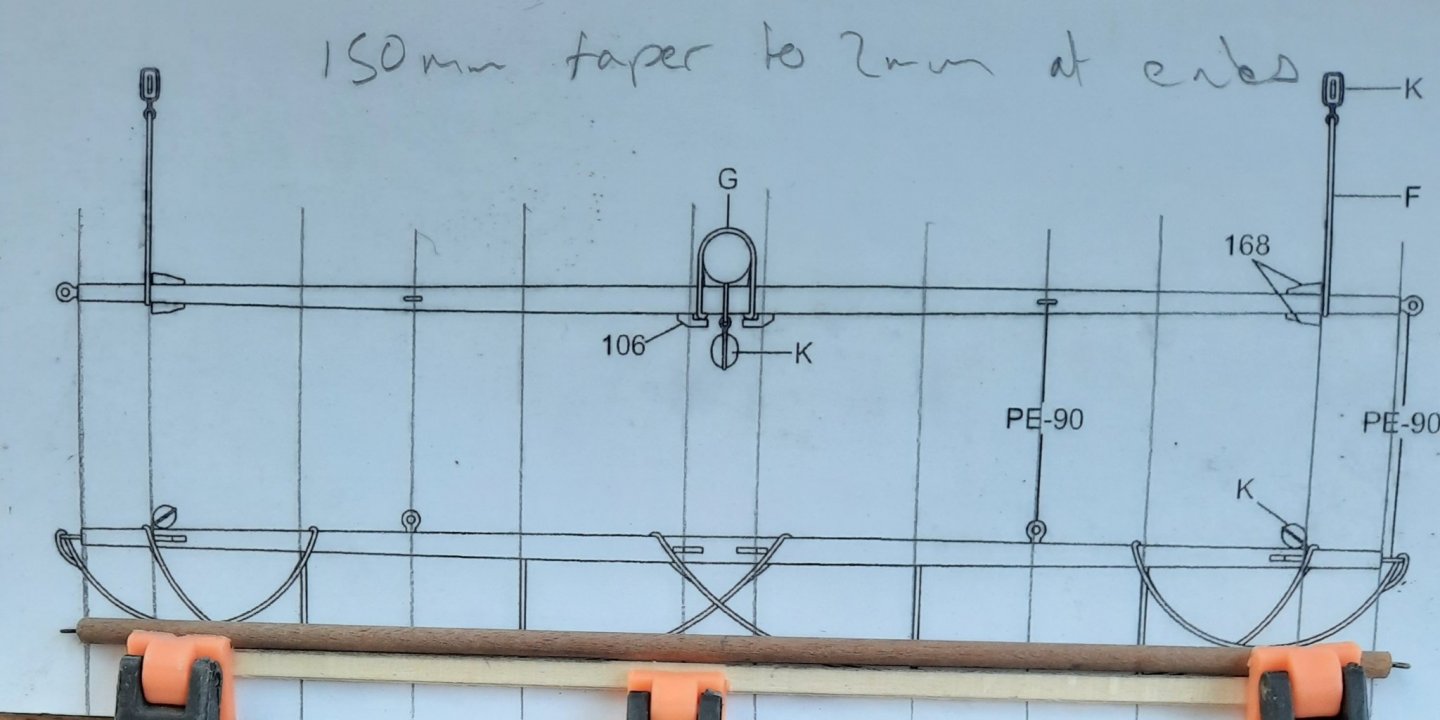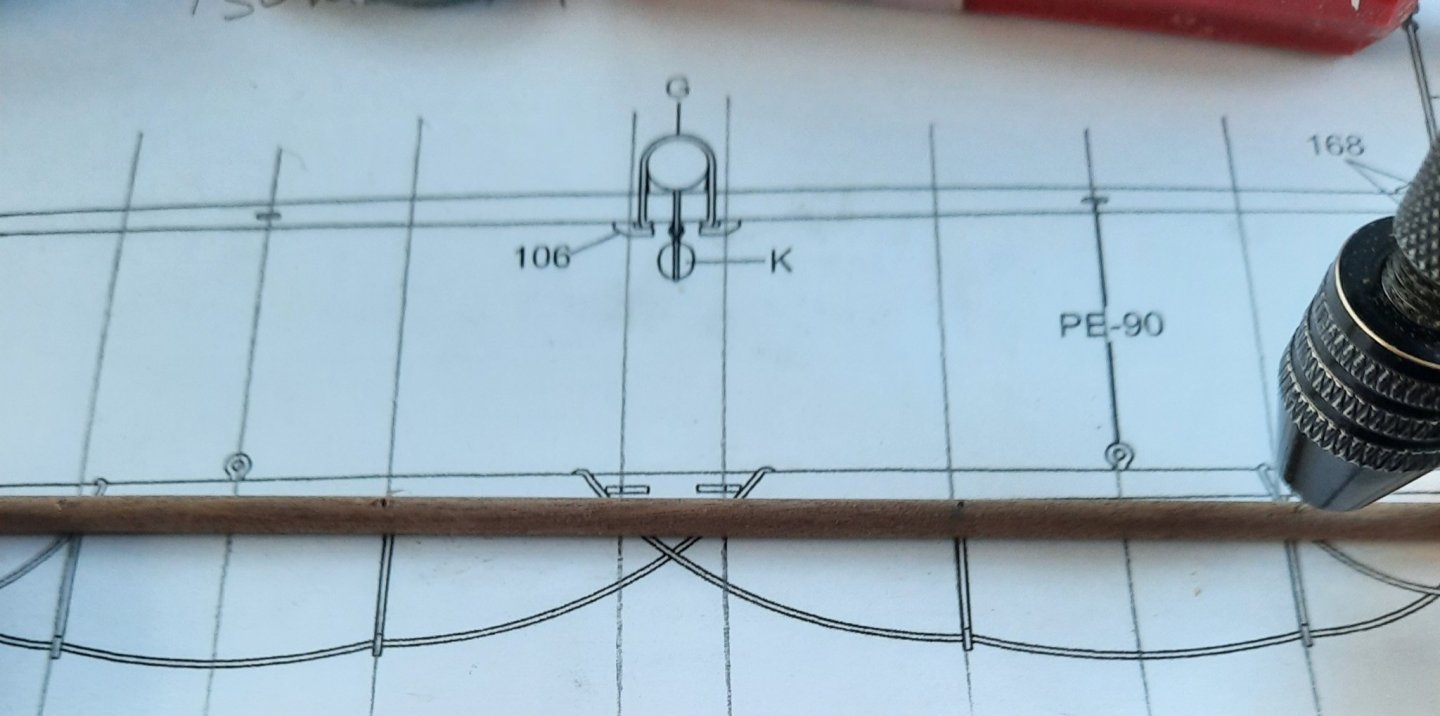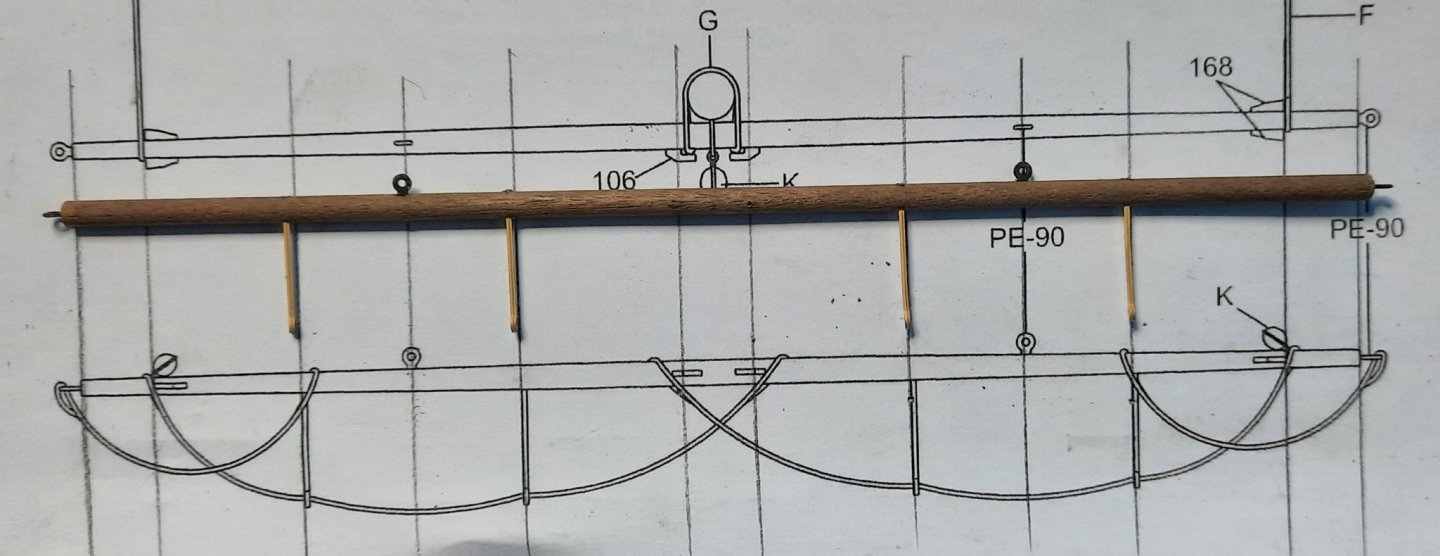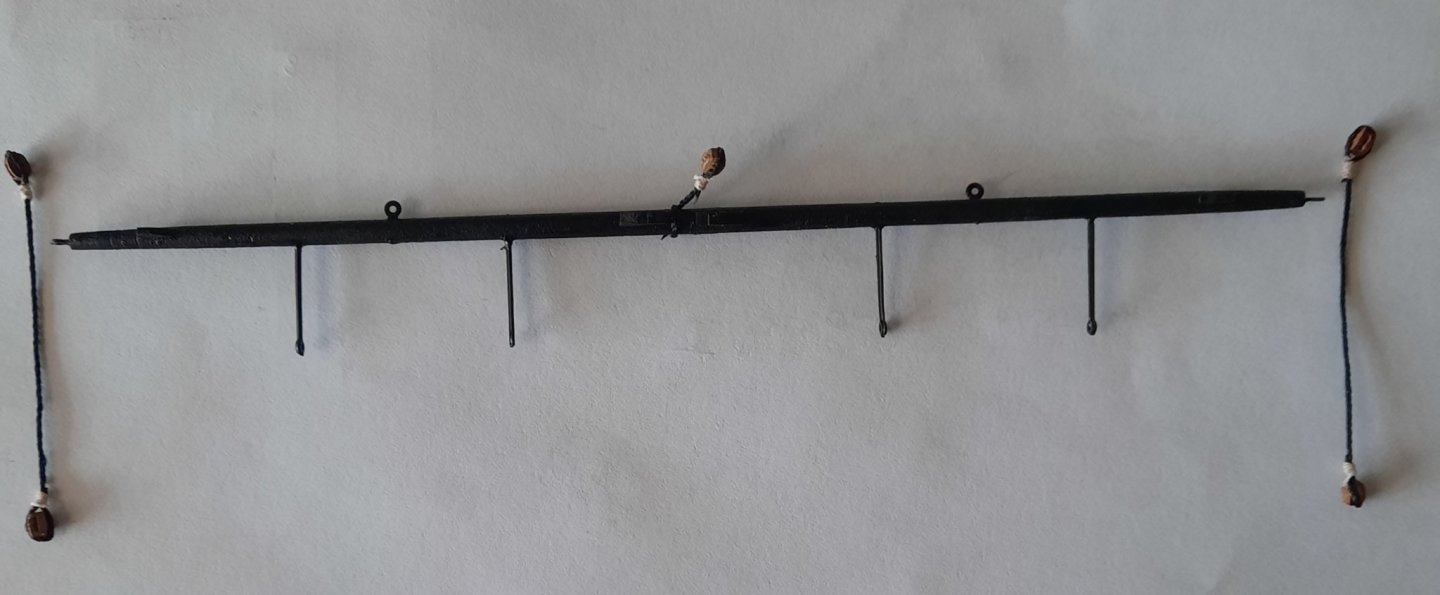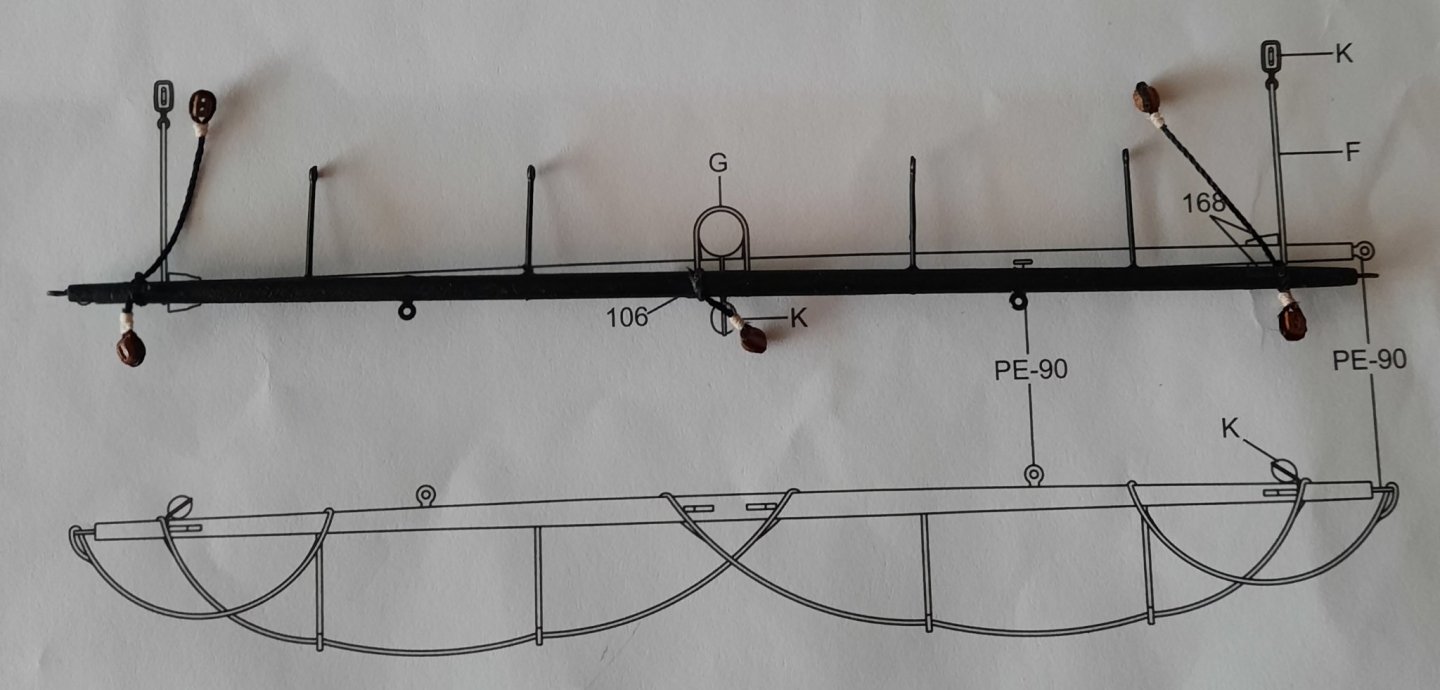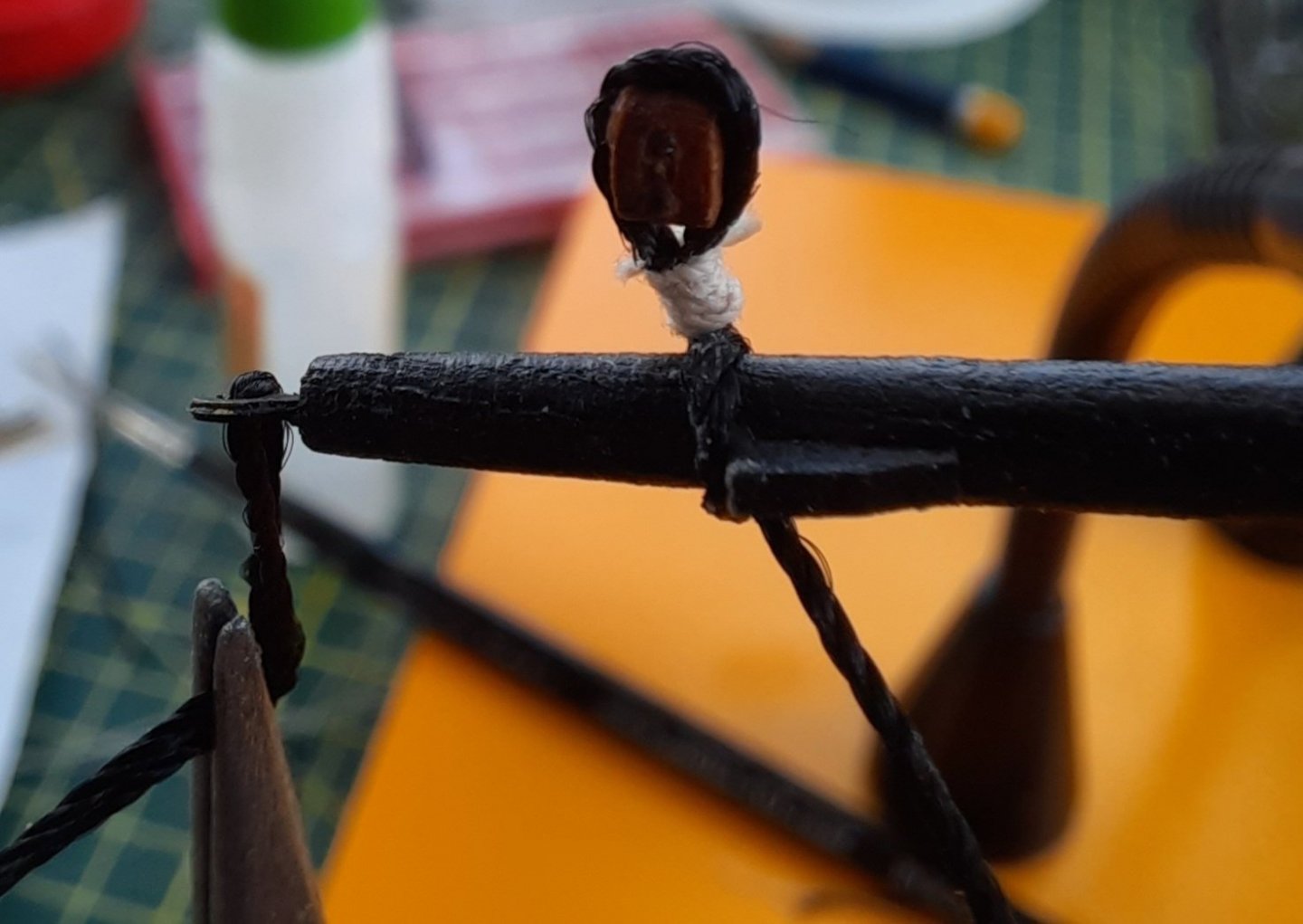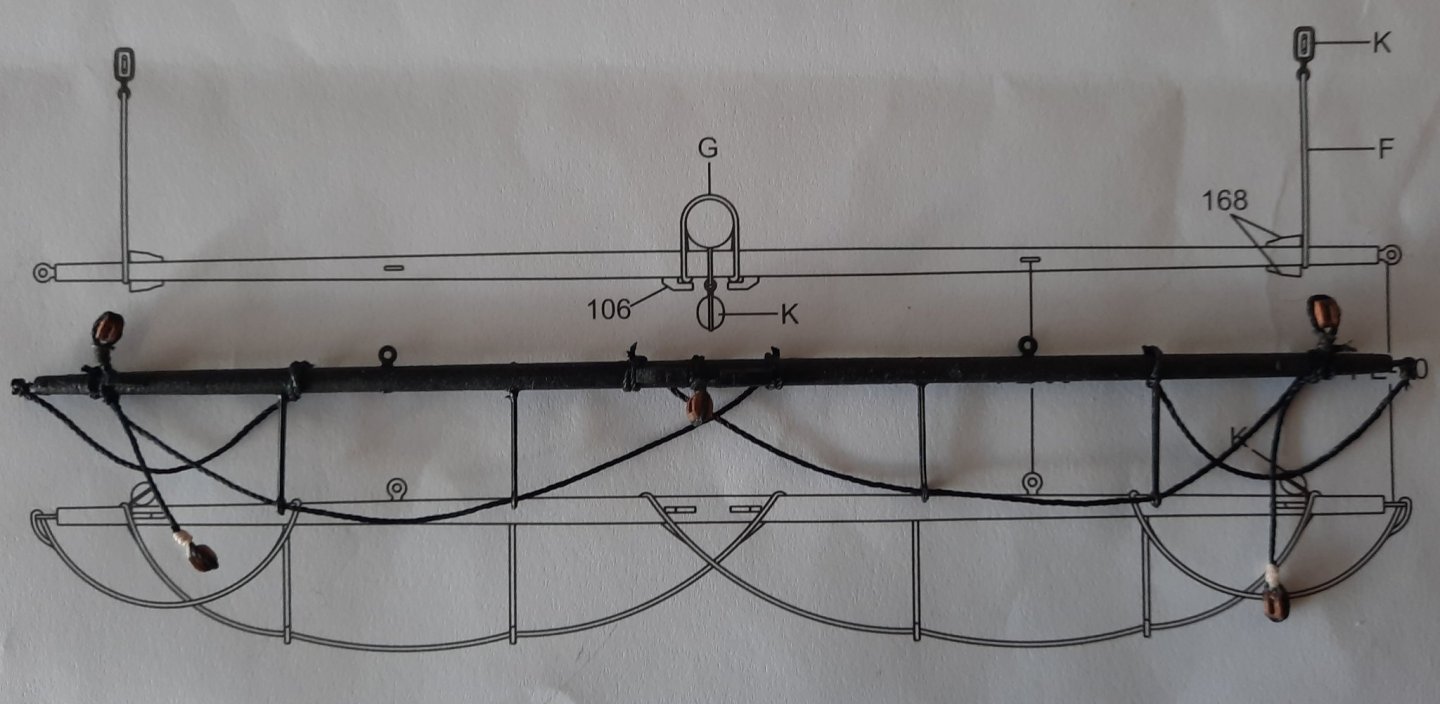-
Posts
2,988 -
Joined
-
Last visited
Content Type
Profiles
Forums
Gallery
Events
Everything posted by Glenn-UK
-
I am in the process of adding the all the blocks and deadeyes to fore, main and mizzen masts, including their respective top and top gallant masts. It feels like I am doing a lot of work but I'm making very little progress. That said I should have completed this in the next day or two and can then make a start on adding the standing and running rigging. This afternoon I have made both the 2 x fore yard lifts and 2 x main yard lifts. Each of these lifts requires a 3mm and a 5mm single block. I was not sure how to go about this task. I have detailed my first method below. I found this method was relatively straightforward and both blocks were secured together as one assembly. I do have another idea for securing the two blocks together, without adding the seizing which I will try in the morning. Method 1 - Seizing Blocks I started with the 3mm block which I held in place, using the quad hands. Using the thin fly tying thread I added three loops of seizing, using half hitch knots top and and bottom. Next I positioned the 5mm block and clamped the thread in place Using top and bottom half hitches I seized the 5mm block in place As I was using white seizing thread I applied a touch of black between the two blocks. After about an hours effort I had completed all 4 yard lifts, which now just need to be tied to the masts. Method 2 - Not yet tried but will reduce the gap between blocks a) Secure a 3mm block with thread using a reef knot. b) Add the 5mm block, and clamp the thread in place c) Secure a 5mm block with thread using a reef knot (or maybe add a seizing).
- 382 replies
-
- Vanguard Models
- Duchess of Kingston
-
(and 1 more)
Tagged with:
-
I know what you mean, rings would be accurate but as I am only adding partial cannon rigging for decoration purposes I think the lack of rings will not be noticed once the standing and running rigging has been completed. I have no plans to move my cannons either.
- 382 replies
-
- Vanguard Models
- Duchess of Kingston
-
(and 1 more)
Tagged with:
-
Thanks Jim, I will be starting the main rigging in the next week or two.
- 382 replies
-
- Vanguard Models
- Duchess of Kingston
-
(and 1 more)
Tagged with:
-
Much appreciated. I have been rigging my cannons following your method. I have found the fly tying thread a really improvement for my seizing.
- 725 replies
-
- vanguard models
- speedy
-
(and 1 more)
Tagged with:
-
Today I have started to rig the cannons. I am undecided if I will add the inhaul tackle but I have added the breach rope to the first 3 cannons. I started by seizing an eyebolt to a length of natural thread, using black fly tying thread, as can be seen in the photo Once I had seized the eyebolt I threaded the breach rope through the two cannon eyebolts and then set about seizing the other eyebolt. I have tried to show this in the next picture, which is a little bit blurry. The end result The cannon was then place on deck and the eyebolts inserted in the two holes on the bulwalks.
- 382 replies
-
- Vanguard Models
- Duchess of Kingston
-
(and 1 more)
Tagged with:
-
Great work as always. I would love to see a side on picture of your wire catherpins😀
- 725 replies
-
- vanguard models
- speedy
-
(and 1 more)
Tagged with:
-
All work on the lower masts and lower platforms is now complete. I did not encounter any problems with completing this aspect. Speedy is hiding in the background With regards to adding the wolding to the fore and main mast it was a straightforward task. I started by marking the various position, using tape. Next I took a length of black thread and clamped the loop. I added 5 full turns and then 6th turn was feed through the loop, as shown in the plan drawing. To finish off I applied a very diluted solution of pva over the wolding. It took me around 10 mins to per mast to complete. Once that was I done I added the cleats, deadeyes and blocks to the fore and main masts.
- 382 replies
-
- Vanguard Models
- Duchess of Kingston
-
(and 1 more)
Tagged with:
-
Thanks Rusty. I should be starting the rigging in the next couple of weeks, just a little bit bit work left on the yards and masts. Also the 6 cannons need rigging. Busy times ahead.
- 382 replies
-
- Vanguard Models
- Duchess of Kingston
-
(and 1 more)
Tagged with:
-
I am currently adding the deadeyes to the channels, the starboard side is complete. With previous builds I secured the strops in the channels using a 2 part epoxy resin glue. For this build I have opted for a different method which I have detailed below. There may be better ways to tackle this task, but I found this method worked really well. I added the 6 off (per side) 3mm deadeyes to the channels first and then added the 9 off (per side) 5mm deadeyes. Step 1 - The strop was bent into shape prior to being placed in the channel. I used my round nose pliers for this task. Step 2 - With the strop in position I used a 0.5mm drill to make the hole in the hull for the pin. I found this to be the most fiddly part of the process. Where possible I used a full length pin but in some cases this was not possible so I used a shortened pin. Step 3 - I did apply a touch of pva behind the strop and on the pin shaft as the pin was inserted. Once the pin was fully inserted the excess pva was wiped away. Step 4 - pva was added to the channels slots around the strop. I found it best to use a fine paint brush for this step. Once I was happy I had the slots had plenty of glue the excess pva was wiped away. As the glue cured and dropped a bit in the channel slots I did add more pva as can be seen in the next photo where all the deadeyes have been fitted to the channels and I have topped up some of the slots with pva.
- 382 replies
-
- Vanguard Models
- Duchess of Kingston
-
(and 1 more)
Tagged with:
-
At an outrageous cost of £20.00 for materials and about 2 hours of my time and effort I have designed and built a bespoke serving machine. I have not tried it out as yet, but it was a fun project.
- 382 replies
-
- Vanguard Models
- Duchess of Kingston
-
(and 1 more)
Tagged with:
-
I have added all the cleats and footrope stirrup's to the mizzen yards. I was planning on adding the blocks and then moving on to the main and fore yards. However I got a bit side tracked as I have been thinking about serving the lanyards. Chuck is unable to ship his serving machine from the USA to the UK due to COVID so I have bought some gears and some brass tubing and I will now see if I can build one myself. Then I thought about the best way to add the lanyards, i.e.: a) with a full assembled mast installed add the lanyards, seizing them around the masts, as indicated in the manual b) add the lanyards prior to installation of the mast assembly c) Install the masts in turn, adding the lanyards before the mast cap is fitted, which is my normal method As I continue to ponder the lanyards I decided to complete platform assemblies. Mizzen mast platform installed I then added all the channels to the hull. This was a bit more time consuming than I first thought, as it was essential to ensure the channel support pins matched the holes provided in the hull. I used a 0.5mm drill to add the support pin holes in the channels. I also ran the 0.5mm drill through the hull holes to get a bit more depth for the support pins. Mizzen channel test fit The channels require a total of 12 x 3mm deadeyes and 18 x 5mm deadeyes. I drilled each 3mm deadeye lanyard hole with a 0.6mm drill and each 5mm deadeye lanyard hole with a 0.7mm drill which should aid the lanyard rigging. I used my round nose pliers to stretch the strops so the deadeyes could be fitted and then used them again to close the strop around the deadeye. 3mm deadeye and strop assembly 3mm & 5 deadeye and strop assembly, a couple of deadeyes need to realigned.
- 382 replies
-
- Vanguard Models
- Duchess of Kingston
-
(and 1 more)
Tagged with:
-
I took a quick picture this morning with the spritsail pinned in place, this will be removed and glued and lashed in place during the rigging phase. On with adding fixtures and fittings to all the yards and tapering. My fly tying thread has now been dispatched so I will also look at the rigging of the 6 off cannons when that arrives.
- 382 replies
-
- Vanguard Models
- Duchess of Kingston
-
(and 1 more)
Tagged with:
-
Thanks Rusty. I think I will fix in place and add the gammoning once the foremast lanyards / ratlines have been completed as I think, looking at the bowsprit rigging plans, will be easier.
- 382 replies
-
- Vanguard Models
- Duchess of Kingston
-
(and 1 more)
Tagged with:
-
Matt They are certainly are very small, but not too bad with the magnifier headset. The quad hands are also a very useful tool
- 382 replies
-
- Vanguard Models
- Duchess of Kingston
-
(and 1 more)
Tagged with:
-
Thanks Matt, it was all straightforward, apart from the deadeye ring assembly which did test my patience and eyesight.
- 382 replies
-
- Vanguard Models
- Duchess of Kingston
-
(and 1 more)
Tagged with:
-
JIBBOOM The jibboom required a 3mm single block adding. I ran a 0.6mm drill through the 3mm block holes to help when the rigging is added. I seized a length of black thread to the 3mm block which was then attached to the jibboom. Seized block on Jibboom BOWSPRIT The bowsprit requires the following items to be fitted: a) 11 x cleats b) 1 x bowsprit fairlead c) 2 x bowsprit bees d) 1 x jibboom saddle e) 1 x 5mm deadeye f) 1 ring comprising 1 x 5mm deadeye and 3 x 3mm deadeyes. g) 1 ring comprising 1 x 5mm deadeye and 1 x 3mm deadeye. As indicated in a previous post one I had already added a centre line to the bowsprit dowel. The positions of the cleats, bowsprit fairlead, bowsprit bees and jibboom saddle were marked and then glued in place, using wood glue. Picture of Bowsprit with fittings added I seized the three 5mm deadeyes and attached the single one to the bowsprit. Picture of seized deadeye 3 x 5mm deadeyes seized, bowsprit and jibboom also shown I then moved on to making the ring of 4 deadeyes. I had marked a piece of tape with the approx. positions of the various deadeyes. I started by adding the 3mm deadeye in the 4 o’clock position. I used the method detailed by Derek (DELF) in his Speedy log. The 3mm block was seized but before any ca was applied and the ends trimmed. Following the method detailed by Derek I was able to adjust position of the deadeye, first by checking with the tape markings and then double checking with it position on the bowsprit. I applied a touch of ca and trimmed the seizing ends once I was happy with its position on the ring. I repeated the process to add the 3mm deadeye in the 8 o’clock position. Starting to make loop for 8 o'clock 3mm deadeye. Using quad hands 8 o'clock deadeye loop formed and ready for deadeye and adjustment to correct position Deadeyes now fitted and ready for final 6 o'clock deadeye I applied a small touch of ca gel to the two cleats and applied tension to the ring and pushed it into the cleats. I was able to add the final 3mm deadeye in the 6 o’clock position. The 3mm deadeye in the 6 o’clock position was seized on the same thread as the 5mm deadeye for the 2-deadeye ring. I checked it was in the right place, prior to securing to ca and trimming the excess thread, first by the marks on the tape and then by positioning it on the bowsprit. I applied a small touch of ca gel to the two cleats and applied tension to the ring thread and pushed it into the cleats. A reef knot was used to complete the process. I fitted the 6 off eyebolts to the bowsprit cap; a 0.7mm hole was drilled for each eyebolt. I did fit the 3 off 3mm blocks, two on the bottom pair of side eyebolts and one to the bottom eyebolt before they were added to the bowsprit cap. I included a loop on the bottom 3mm block. I used the same method for adding a loop to a block as detailed in Derek’s (DELF) Speedy build log. The bowsprit cap was then glued in place, again using wood glue. The ends of the bowsprit and jibboom were both then painted black, covering the area from the bowsprit cap to the first set of cleats. Finally, the jibboom was attached to the bowsprit, with wood glue applied to the jibboom saddle and bowsprit cap hole and finished off with the strapping. Bowsprit and Jibboom dry fitted - gammoning still to be added Bowsprit and Jibboom dry fitted - gammoning still to be added
- 382 replies
-
- Vanguard Models
- Duchess of Kingston
-
(and 1 more)
Tagged with:
-
Nice work Rusty. I am going to experiment with adding the rear tackle with custom made hooks. I am not adding the side tackle.
- 201 replies
-
- Duchess of Kingston
- Vanguard Models
-
(and 1 more)
Tagged with:
-
Thanks Rusty. I like to share my methods, even though they may not be the best way to do things. Hopefully they will provide some help.
- 382 replies
-
- Vanguard Models
- Duchess of Kingston
-
(and 1 more)
Tagged with:
-
Following my recent posts on shaping the masts I thought I would detail my method(s) for completing the spritsail. The method outlined below will then be used to make the yards. The spritsail is made from a 150mm long length of 3mm dowel. It requires the following work to be undertaken: a) Fit 3 x eyebolts, 4 x footrope stirrups, 6 x cleats and 5 x 3mm single blocks to the dowel. b) Taper the dowel to 2mm at each end, with no taper on central section c) Add the footrope stirrup rigging. d) Add a small pin to secure the spritsail to the bowsprit. The footrope stirrups will point downwards but will also angled toward the bow. This arrangement is shown on page 69 of the build manual, reference instruction 235. Stage 1 – Preparing the Spritsail for the eyebolts and footrope stirrups. I tried two different methods both of which are detailed below. I found both methods had problems, but these problems could be eliminated by using a combination of both methods. Method 1 – No Power Tools Used A photocopy of the spritsail arrangement (from plan sheet 10) was made. With the 3mm dowel cut to the required length of 150mm a piece of 1.5mm plank (surplus from a previous build project) was clamped to the dowel so a centre line could be added. Please see the photo below. The position of the eyebolts and footrope stirrups were marked along the centre line. The holes were drilled using a hand drill with a 0.7mm drill bit. I drilled right through the dowel, knowing the holes would not be visible after painting. This also meant all the holes could be drilled without the need to rotate the dowel. The holes at either end of the dowel were also drilled with a 0.7mm drill. The eyebolts and footrope stirrups were then test fitted and their position was checked against the plan. Method 2 – With Jig and Power Tools I was a little bit concerned with being able to consistently drill through the dowel in a straight line by hand. Therefore, I made a jig which could be used with my bench drill to ensure I was able to drill true. The jig was quick and easy to make. The two guides are 1.5mm planks. I drilled 3mm holes in the two clamps and then (using my mini bench saw) trimmed the bottom edge away. Photo of Jig With the dowel positioned in the jig a centre line was drawn. The dowel was then rotated through 90 degrees, so the centre line was on top. A photocopy of the plan drawing was placed on the bottom guide and then hole positions were marked on the dowel. Using the Jig With a 0.7mm drilled fitted in the bench drill (I have an adapter for micro drills) the holes were added, and the spritsail was then fitted with the eyebolts and footrope stirrups. Ready to drill a hole The problem with this method was the positioning of the bench drill. A couple of the holes drilled seemed to straggle the centre line. In the end I opted to use a combination of both methods which produced the best results. I used the jig to mark the centre line and hole positions. I then used a hand micro drill to start each hole. With the dowel back in the jig I was able to drill through the dowel. Stage 2 – Tapering I used my bench lathe to taper, as detailed in previous a previous post. I did not taper the centre section of the dowel. Stage 3 – Adding Fixtures and Fittings Using ca gel, all the cleats, eyebolts and footrope stirrups were added. The mast painted was then painted black. Next task was to add the 5 off 3mm single blocks. I started by running a 0.6mm drill through the 3mm block holes for clearance. Next a length of 0.5mm black thread was seized to the first three blocks, using 0.1mm natural thread. The seizing method used is as described in detail by Derek (DELF) in his Speedy build log. It yields brilliant results as can be seen in the next photo. Seizing of a block 3 blocks seized There two blocks required for the spritsail lifts which are positioned at each end of the spritsail, positioned by the cleats. Two blocks are also required for the spritsail braces which are also positioned by the same two cleats as the spritsail lifts. The braces have longer tails which keeps them away from the spritsail. I decided to seize one lift block and one brace block to a single length of thread. This thread could then be tied to the spritsail, ensuring the blocks are correctly positioned. It reduces the thread clutter around the cleats noting there is a footrope stirrup thread to be seized by the same cleats on the spritsail. After a making a measurement the distance between the two blocks is approx. 40mm. Using the quad hands this turned out to be a relatively simple task to produce two (almost) identical seized blocks. Brace and Lift blocks All the blocks were tied to the spritsail. I used a simple knot with a touch of ca applied to the knot. The final task was adding the footrope stirrup rigging. I used 0.5mm black thread for this. I found it necessary to run a 0.7mm drill through the footrope stirrup eyelets. This was a straightforward task. As each rope was added I tried to ensure that it followed the shaping detailed in the plans. Start of the footrope rigging process The completed spritsail assembly, which looks a good match with the plan.
- 382 replies
-
- Vanguard Models
- Duchess of Kingston
-
(and 1 more)
Tagged with:
About us
Modelshipworld - Advancing Ship Modeling through Research
SSL Secured
Your security is important for us so this Website is SSL-Secured
NRG Mailing Address
Nautical Research Guild
237 South Lincoln Street
Westmont IL, 60559-1917
Model Ship World ® and the MSW logo are Registered Trademarks, and belong to the Nautical Research Guild (United States Patent and Trademark Office: No. 6,929,264 & No. 6,929,274, registered Dec. 20, 2022)
Helpful Links
About the NRG
If you enjoy building ship models that are historically accurate as well as beautiful, then The Nautical Research Guild (NRG) is just right for you.
The Guild is a non-profit educational organization whose mission is to “Advance Ship Modeling Through Research”. We provide support to our members in their efforts to raise the quality of their model ships.
The Nautical Research Guild has published our world-renowned quarterly magazine, The Nautical Research Journal, since 1955. The pages of the Journal are full of articles by accomplished ship modelers who show you how they create those exquisite details on their models, and by maritime historians who show you the correct details to build. The Journal is available in both print and digital editions. Go to the NRG web site (www.thenrg.org) to download a complimentary digital copy of the Journal. The NRG also publishes plan sets, books and compilations of back issues of the Journal and the former Ships in Scale and Model Ship Builder magazines.



